#tips to improve executive functioning
Explore tagged Tumblr posts
Text
Hi everyone,
I found a helpful article from Psychology Today talking about some tips to help with executive functioning skills and how you can strengthen them. The article goes over these 7 strategies:
ADHD and Stronger Executive Functioning Skills
7 tips for improvements without medication:
1. Inhibition and Emotional Control
2. Initiation
3. Organization
4. Prioritizing
5. Sustained attention
6. Working memory
7. Goal-directed persistence
The full article will be below if you want to read more. I hope many of you find this helpful.
ADHD
Executive Functioning
#adhd#adhd post#executive functioning#tips to improve executive functioning#adhd & executive functioning#feel free to reblog/share#source: Psychology Today#tw bright colors#tw eyestrain
116 notes
·
View notes
Text
I feel like people have also pushed the social model of disability as the only valid model for explaining autism so much that it became just straight up misinformation. Like, listening to some autistic people on tiktok, it's like you can accommodate autism to such an extent that it stops being a disability or even a problem whatsoever. And maybe for some specific combination of traits this is true, but my guess is that it's quite rare. For most people who meet the current diagnostic criteria, autism would disable them in any context, especially since it is almost always comorbid with at least one other thing if not multiple, such as anxiety, depression, PTSD, connective tissue disorders, epilepsy, ADHD, intellectual disability, dyslexia/dyscalculia/dyspraxia, auditory processing disorder... the list goes on.
Point is, of course accommodations, support, and a good environment can eliminate a lot of negative aspects of autism - but most autistic people are disabled by our neurotype and it cannot be accommodated out of existence. Accommodations can drastically improve our quality of life, but not make us function on the exact same level as neurotypical people. And because activist circles and tiktok and so on have an overrepresentation of people whose combination of traits allows them to function on a relatively normative level, people forget just how many struggles you can have, even as a low support person. Like some people think that needing help with filing paperwork or keeping your house clean is high support. That's not even mid support imho, that's something the vast majority of low support autistic people would benefit from. I'm mid support and I need help with tying my shoelaces and preparing simple meals - and I have a master's degree and no learning/intellectual disabilities.
Two things can be true at once. Yes, autism is a natural variation of brain types and we deserve the same rights and dignity as everyone else. Many of us would not want to be "cured" of autism and it is a part of us. Also, yes, it disables us, and limits our functioning, and can be (and is, for many people), a very negative experience, especially in the current world. It's not either or, it's not black or white. It is a complex neurodevelopmental difference that doesn't just boil down to being sensitive and passionate. And it does suck sometimes, maybe even a lot of times. Abled people should learn to respect us and our wishes and needs without either comparing autism to cancer or sugarcoating our experiences.
the way people online talk about autism is getting really weird, like do they know that neurotypicals still have interests? that someone being passionate about a hobby doesn't mean they're autistic? you guys know that right
#accidental rant i gues#i feel really weird as a mid functioning person as well#like my skill profile is very spiky#and people tend to think that because i have a stem degree and a bunch of advanced skills#means i don't struggle much and am low support#meanwhile i basically do not leave the house without supervision#and frequently lose the ability to communicate verbally in unfamiliar situations#and like right now im burnt out and sick so i have less ability to mask#almost no ability tbh#but even at my best i have pretty limited ability to cope with change and unfamiliar environments#and very poor motor skills#and just god awful executive functioning#so i dont relate to late diagnosed people much#but also i was only diagnosed at 18#i didn't have speech delays#and i used to be pretty good at masking so i could pretend to be somewhat normal at uni#so yeah. it's complicated and i feel weird about it#also being in hyper positive autism acceptance circles kinda persuaded me#that i could accommodate myself out of being disabled#like some autism acceptance places even ban the word disabled#which i fucking hate#cause for years i believed that if i could just learn more tips and tricks#i could function on the same level as an abled person#which made me burn out so fucking bad#when instead i should have just focused on improving my quality of life#and stop accessing my achievements by nt standards#anyway rant over
80K notes
·
View notes
Text
having just sort of a Night
#could physically Feel myself getting to that point of “hasn't seen humans in long enough that it's Bad”#this usually hits for me around the 72 hour mark moving up or down depending on how long it's been since i've shared a bad#but it's also that tipping point where i'm in a 50/50 split between “oh i need humans” and “actually what if i just didn't make an effort t#see anyone again ever"#was leaning hard towards option two when meg had to cancel which is when the [i'm in danger] feeling Hit#i don't feel. like. BAD. but i'm having an adjustment coming off gabapentin so i Need to do things that give me purpose#and i was halfway through cleaning the apartment when they called#stopped dead intending to finish and simply Didn't#but i fed myself switched my laundry and did some actual flight rising planning#and finally and i'm most proud of this one#i FINALLY quit my part time job#i fully intended to give them two week's notice but kept procrastinating then got hit with massive guilt which of course got worse#my boss was really nice about it and i guess one week is better than nothing#i have a feeling i'm going to feel much better tomorrow and that my executive function is going to improve bc that was REALLY weighing on m#idk why i just couldn't fucking make myself do it#i even fucking brought it up in therapy fully intending to quit that day#and. Didn't.#oh i also emailed my therapist to discuss esa paperwork! AND i read fetch api documentation in prep for maaaaybe testing into the advanced#code the dream class#i guess i did a lot today it just feels like all i did was sit in front of the tv#i'll feel better tomorrow. i will.#thing is. i'm much better at coping with being unexpectedly alone than coping with being unexpectedly with people.#i know how this works. i'll be okay. i'll be okay#i'm going to finish my audiobook and go to work and code and text my friends#i will be fine#i just feel a little lonely and weird tonight and i need more vitamin d and also to remember to take my meds#thane.txt
1 note
·
View note
Text
ADHD TIPS: FOR THE NONMEDICATED AND THE MEDICATED
obviously, ADHD is not the same for everyone who has it. if you dont have ADHD, or aren't sure, but experience issues with executive function, memory, impulsivity, and emotional regulation, these tips can still be helpful!!!
practice radical self forgiveness
keep a notebook/journal
give your items a home
keep baskets, boxes, and bins, especially clear/mesh or anything that lets you see whats in it.
buy fruits/veggies/anything that spoils super quick the day youre going to use it
keep a list of easy meals
keep a trash receptacle in Every room
when you notice something dirty piling up, clean for just 5 minutes
do NOT worry about completing necessary chores. just do a little
if you need it frequently, keep it in sight, but off the floor if you can.
check under your bed, couch, or other corners where stuff can pile up when you get that random energy spike.
take a multivitamin, and cut down on soda (or other highly sugary food/beverages) if youre able. seriously!
specifically for the medicated!
take your meds, go to bed, and wake up at around the same time every day.
being vitamin deficient can make your medicine less effective. magnesium, B vitamins, omega 3s, and vitamin D might help. if you dont eat a lot of fruits, veggies, and fish, you are likely deficient in these at least.
stay. hydrated. For the love of god
try things you had trouble doing before medication
dont expect medicine to fix you
dont blame medicine for all of your improvement
no 2 people are the same, and what works for me might not work for you. i am likely on the spectrum, and i wasnt medicated at all for my ADHD until i was 17, and i wasnt on the right medicine until i was 21. i would recommend keeping that in mind while considering my tips!!
i will elaborate on these tips under the cut!
practice radical self forgiveness
i think this is the most important of all of these tips, which is why i put it first. i know its easy to look down on ourselves for our disability. but you must acknowledge this: you are disabled. you have a disability. you cannot hold yourself to the "normal" standard. more than likely, you grew up in an environment that didnt teach you how to navigate the world as you are, either. thats okay! we must teach ourselves.
try to view yourself as both the teacher/parent, and the child. when you forget something important, or make a careless mistake, or give into impulses, or say youll do it later and dont, or go too long without a bath, or let the trash pile up, you have to be kind to yourself. the child within you needs it. these things simply dont come naturally to us.
you must apologize to yourself as the child: im sorry i didnt pick up the trash. i know it makes the place dirty, and overwhelming. i will do my best to improve. i love you. you must forgive yourself as the parent: its okay, pumpkin. i forgive you. i know you didnt mean to make me overwhelmed, or to invite dirt into the home. i will help you improve. i love you. you also must do the reverse, apologize as the parent: im sorry, child. i did not teach you how to know you should pick up the trash. i did not teach you to recognize dirt. i will do better, and i will help you as best i can. i love you. forgive as the child: i forgive you. i know you are doing your best to lead me, and teach me what you know. you werent taught to pick up and see dirt either, were you? as long as you support and love me, we can figure it out together. i love you.
i know, to think this way can feel infantilizing sometimes. and its much harder to teach ourselves these habits. if its available, its okay to ask for help. just dont be too hard on yourself when your disability impairs your ability to be "normal." our habits die harder than most. even if you forget to maintain a habit, just do it when you remember.
2. keep a notebook/journal
i know, i know... every ADHDer HATES this tip. but it seriously works. dont hold yourself to a rigid standard when using it. i prefer dot grid journals, so i can write notes, or sketch, or make lists, or otherwise neatly divide pages how i wish, rather than it being blank/horizontally lined.
i dont keep a to do list all the time, i dont journal every day, i dont even look at the thing every day. there is no right way to use your journal. i use mine for many things at once: if i forget a notebook for class, or my laptop dies, i put my class notes in there. i put random doodles, layouts, oc pages, Big Feelings, and weekly/daily plans/to do lists. i dont obsessively keep up with it, or update it every day.
i DO use it when i feel overwhelmed. if i feel like 50 different things need to be done in 3 different domains and i dont know where to start, i write them down as i think of them. here is my typical order of operations (it took me a while to figure this out. i struggle deeply with prioritization.)
first, i write everything down i can think of that that moment. second, i label them necessary, important, and least important. third, i label how long they take (most time, some time, least time) finally, i start with the most important one that is the least overwhelming
now, i dont have an easy time labeling importance and time taken, of course. that can be the hardest part. but i dont worry so much about accuracy of my labels. i havent got it all down because i will almost always prioritize schoolwork over housework and hygiene, but we cant be perfect. the MOST important thing is always your health and safety.
dont worry about finishing a todo list, either. the most important thing is getting stuff you can forget on paper where you can look back at it when youre overwhelmed. you should keep your journal somewhere you access frequently or can see it.
also, the journal helps with big feelings. if youre feeling that white hot anger, the itching impulsivity, or rejection sensitivity, or anything that makes you think "i cant do this," start jotting words or pictures down. it can be anything. this will help when you feel that feeling the next time. we often get stuck in loops because we dont remember what caused a feeling or conflict, so we make the same mistakes. when you write it down, you can take your own word for it when you make a mistake. this makes it easier to recognize when youre falling into a pattern, and makes it easier to change your response.
3. give your items a home
if you arent constantly using something, or go more than a day without using it, send it home. an objects home is just somewhere it comes back to when its not needed, so that it isnt taking up space where it isnt needed. things like snacks, laundry (clean and dirty), art/craft/hobby materials, coats, electronics, plushies, anything. personify your stuff just a little bit- if you cant use it anymore, it cant find a home with you-- you have to send it on trash vacation. your coat wants to go home! pick it up and take it there when you can. its okay if that home isnt permanent, or if you lack materials/money to create a proper home. our coatrack is a chair right now, which is a much comfier home than the floor.
4. keep baskets, boxes, and bins, especially ones that are see through/visible
this helps you give your items a home. if you buy storage, get something stackable too, but even a cardboard box works. keep like objects together! and keep them near what theyre used for.
5. buy fruits/veggies/anything that spoils quickly the day youre going to use it
its sooo tempting to try to eat healthy and save money by stocking your fridge full of healthy produce and raw meat, but unfortunately i know how much money we waste forgetting/not having the energy to use them. if you need a fresh fruit, veggie, or meat, for something you are definitely planning on cooking, buy it the day of. if you have something in your fridge you dont think youre going to use before it rots or molds, stick it in the freezer!!!
also, frozen and canned fruits, veggies, and meats are just as good as fresh. they stay good for so long you dont have to worry about it going bad.
6. keep a list of easy meals
things that you can get down your gullet easily, and prepare easily. 1 pan meals, sandwiches, hotdogs, hot pockets, instant oatmeal, canned meals. i typically keep instant oatmeal and those tuna creations packets, as well as club/ritz crackers. also, skillet meals like velveeta skillets and hamburger helper are awesome, just keep some frozen ground beef (or meat of your choice) and youre good to go!
also, eggs last for MUCHHHH longer than the sell by date. i have had eggs 3 months past the date (note im american so they are under refrigeration) that were still good, but obviously that long past the date you should do a sniff test after breaking an egg. eggs are awesome in terms of ease of prep. heat your pan up to temp before cooking and they wont stick so bad. use cheese or milk to make a desirable texture for scrambled eggs or omlettes. dont forget salt and pepper (necessary...) you can also stir an egg and peanut butter into instant ramen for some actual nutrition. i also keep onion powder, paprika, and cayenne for yummy eggs.
in the egg vein, french toast is extremely easy and filling, and will sate a sweet tooth with some syrup!
7. keep a trash receptacle in every room
it doesnt have to be big, but having a designated trash spot in your bedroom is super helpful
8. when you notice something dirty piling up, clean for just 5 minutes
you dont have to clean to completion, thats overwhelming!!! but when you see something gross or messy and it bothers you, just take a couple minutes and pick up a little. play a song and tidy until the end of it! cleaning isnt all or nothing!
9. do not worry about completing chores, just do a little
in the same vein as the last one, the most important thing is getting the ball rolling. cleaning can be really hard because of the overwhelm of how bad it is. you can make it less bad a little at a time!
something ill do is sort out and scrape off the dishes before even thinking about doing them. that way, they take up less space and it doesnt look quite as bad. then next time i come to them, i do a bit more. or ill pick up the dirty laundry off the floor, then ill put it next to the washing machine, then ill wash/dry. i dont worry about folding and putting away unless im up for it-- its more important that theyre clean at all.
10. if you need it frequently, keep it in sight, but off the floor if you can.
remember, the floor is the stuff killer! if it must be on the floor, designate a spot.
11. check under the bed, couch, chairs, and piles if you have a random energy spike
i have found so much stuff i didnt even realize i lost. this also prevents pests and the accumulation of dirt.
12. take a multivitamin and cut down on soda (or other highly sugary foods) if youre able. seriously!
in high school i tried eating low-carb for a while. i didnt maintain this diet, but what i did maintain was not drinking soda regularly. when i say my head cleared and i felt less groggy, i mean it. if youre in the position, pay attention to the amount of sugars in what you eat and drink.
i know the "eat well" advice is given out too much, but nutrition seriously matters. if you care to work on your nutrition, do not worry about fat, carbs, or anything like that. just cut down on how often you eat highly sugary foods. you will feel so much better just from that. i have a sody pop as a treat every now and then and i have a whole other appreciation for it :-)
for the medicated:
take your meds, wake up, and go to bed around the same time
your body works on a schedule whether you want it to or not. pay attention to this schedule and try to work with it. when do you usually get tired? when do you prefer to wake up? when do you usually use the bathroom? this goes for nonmedicated people, too. your body will thank you!
2. vitamin deficiency can make medicine less effective. magnesium, B vitamins, vitamin D, and omega 3s can help.
these vitamins are all harmless, except for magnesium, which can slow your heart rate and cause shallow breathing IN HIGH DOSES. luckily, stimulants tend to deplete vitamins/electrolytes like magnesium, which can cause twitches and spasms. dont get large doses of these, 100% daily value is just fine.
3. for the love of god stay hydrated
imagine you are a machine and water is lubricant. stimulants suck up this lubricant to make you run more effectively. however, without extra, the machine will still run like shit. try to drink a whole glass with your medicine, and keep a cup to fill thru the day.
4. try things you had trouble with before medication
its super easy to get discouraged from something when you feel like a failure! try it again now! it may be easier. be sure to give yourself praise for what you do! your effort, your success, anything! this will teach your brain to see stuff through and help you feel and be more competent!
5. dont expect medicine to fix you
adderall, vyvanse, ritalin, none of these are a pill to fix you. they give you the capacity to work on yourself. dopamine is the "go get it" chemical. typically, ours is low and irregular, so we dont feel the drive to "go get it" when we need to, and we dont feel enough of a drive to see something through until we "get it." you still have to put in a lot of effort to fix habits and do work, medicine makes it so its easier. for me, it also reduces Noise in my head, so i can focus better. i still have to put effort into everything, its just less painful.
6. dont blame medicine for all of your improvement
again, medicine gives you capacity. YOU still do it all! its all you!!!!!! :D

thank u for reading i hope these are helpful! i feel like adhd tips are veryyy all or nothing and never explain WHY they may help, so i hope my explanations are helpful!
#actually adhd#adhd#executive dysfunction#neurodiversity#actually audhd#audhd#adhd tips#i figure we need all the help we can get and professionals arent always. the right help. so!#this got pretty long but i hope this is helpful!
797 notes
·
View notes
Text
5 strategies that have improved my executive functioning in 2023
1. Preparing tasks in advance
This tip has been one of the most useful things for me to be able to actually get the things I want to do done without getting stuck in the process. I am very prone to difficulties with task initiation and task switching. Basically I've found that if I check what activities are upcoming for that day in my calendar (but you can use any task that you want to do sometime that day) then I set the task up in advance it's a lot easier to actually do the task.
So if my goal is to stream after dinner then I turn my pc on and have my setup ready to go before dinner. If I want to do a Pilates workout I set up my mat an hour before I actually want to do the workout. If I want to go to the gym I get into gym clothes at the start of the day so I don't have to change later.
I basically eliminate all the difficult prep work and then I find doing the task so much easier when I get to it.
2. Task switching when stuck
A lot of neurodivergent people have issues with getting 'stuck' or 'frozen', myself included. Whether it's autistic inertia or decision paralysis or something else it's very common to find yourself unable to do anything at all. You'll know that even if you put your phone away or stop what you're doing you'll just continue to sit there doing nothing.
The solution to this for me has consistently been to switch goal. I want to get up and shower but can't? I'll find that I can pull my laptop out and get some work done instead (and then shower after lunch later in the day). I am stuck when I want to stream? I find I can do my skincare instead (and I ended up streaming the next day).
Yes this means you don't get your original goal done when you wanted but you get something done, and something is better than nothing.
3. Task chaining
I've found that task chaining is the easiest way for me to get multiple tasks done. It's basically building upon your success. Take the example from my task switching section where I couldn't get myself to start streaming so I decided to do my skincare instead. While doing skincare I remembered I wanted to ask my brother about a particular product. So suddenly I'm capable of going to ask him about it. I couldn't even get out of bed before but now I have the motivation to move (I keep my skincare next to my bed so I didn't have to get up prior to this). After talking to him I decide I can go downstairs and make tea (something I originally wanted to do before streaming but was too stuck to do). While downstairs my mother tells me that she has a pile of laundry for me. I decide to take it back upstairs and put it away immediately. While doing so I figure I may as well sort all the laundry that's piled up on my floor as well.
I've gone from not doing anything to completing 4 separate tasks. If I wanted to get up and put the clothes on my floor away originally I'd never have been able to do it. I built on my successfully completed tasks and chained them together. Of course you should still remember to rest after chaining a number of tasks together.
4. Prioritise harder tasks earlier
I get all my energy at the start of the day and feel quite tired by the end of the day. This is how most people feel due to how our circadian rhythms function. Because of this I have found it's a lot easier to get difficult tasks done in the morning.
So now instead of trying to clean my room or go to the gym at 5pm I'll do it at 9am. I'll save 5pm for my easy tasks, things like studying Korean, meditating, studying geography, and coding. Take some time to figure out which tasks you find easy and which you find hard. If you consistently find yourself unable to do a task that's a hint that it's difficult for you. Vice versa if you're consistently capable of a task it might be a sign it's an easier one for you.
5. Using an AI scheduler
I saved this one for last, not because it's ineffective, it's actually made a huge difference in my life. But it does cost money to take full advantage of this so I put it down the bottom. Still there's a lot to be said for using an AI scheduler. I hate choosing what to do and have always preferred to be told what tasks I should do each day. It also takes a huge amount of mental energy to decide what tasks I should do when each week and organise them in advance.
Enter Reclaim, the AI scheduler of my dreams (there are lots of other ones on the market too like Motion! Take a look around and see if you can find one you like but unfortunately they all seem paid). Reclaim does have a free version but for me their paid version is necessary to achieve my goals.
I set up all my tasks and habits in Reclaim, I can customise how often I want to do things, how long they should take, and what hours I have free. Then I just check my calendar each day and see what tasks I'm meant to do. If I end up taking more time than expected I just hit the 'reschedule' button on a task and it's automatically slotted in somewhere else that week. This has definitely made one of the biggest changes to my quality of life I could probably make a whole separate post about using Reclaim.
That's all the tips that have worked for me this year so far, maybe some of them might help you!
#actually autistic#actually neurodivergent#executive dysfunction#adhd#autism#executive function#long
553 notes
·
View notes
Note
Do you have any Jack Spicer headcannons?
DO I????????
Yea I do let's get into his brain, education, and stunted cultural connections. (Also pro-tip, the entire series in, what I believe is a full digital remaster, is available on dailymotion right now. The quality is immaculate it's like, unbelievably good to look at.)
1. His mother is a second generation Chinese-American, his father is an American businessman. From the architectural structure of his house- and, there aren't any good screencaps I have on hand for this but the interior shots we see of his house that aren't his lab or bedroom- and his proximity to the temple I don't doubt they've relocated to China. That said "Spicer" is a pretty European last name, and nobody come for me but his cousin Megan? That's a little white girl. He's theoretically and functionally closer to Chinese culture, but his education has swayed pretty exclusively western which I'll circle back around to after some context.
2. Despite being closer with his mother than his father growing up, he speaks very, very little Mandarin. His mother speaks English and Mandarin almost equivalently, as she grew up speaking both, but growing up in America with her own American father, English was the language she got more use out of before moving. Jack's father on the other hand can have, at best, a highly stilted simple conversation in Mandarin, He say hello, introduce himself, ask how you are, etc. but not much further in depth. So aside from a few exchanges, English was the primary spoken language in their home. He absolutely can not to save his life read or write in Chinese, traditional or simplified. He can recognize maybe 3 words if they are very, very clearly printed and spaced out. To be fair he isn't great at reading and writing in English either.
3. He has pretty severe dyslexia, phonological and surface. He tends to spell out any words he doesn't know phonetically, and on paper he struggles the most with directional letter orientation, (sz, nu, bdpq, mw) and sometimes formative lines (OQ, NMVW, PRF, XY, Il). A lot of time's he'll either purposefully capitalize a certain letter to differentiate it from a different, similar letter, write the correct letter backwards, or do both. Speaking out loud is much easier, but still presents occasional difficulties, especially with words that change with plurals/tenses in ways other words don't. (house->houses= mouse->mouses + years of "No Jack it's mice" = mouse->mices).
4. This does not change the fact that he's very, very intelligent. He has an exceptional grasp on engineering which we see in the show, but it's more than just welding metal together. He's able to develop schematics for complex machinery and execute them in record time. The boy made An Actual Working Time Machine That Worked. If you put a piece of paper with a complicated mathematical equation written on it in front of him he would look at you like you just asked him to perform a miracle, but if you, out loud, pose a hypothetical scenario in which the same equation could be applied, without even specifying the equation itself, he could run the numbers in his head and he could do it fast. Written numbers, ESPECIALLY with variables presented as letters, are like looking at alphabet soup. You write A²+B²=C² and he assumes you're stupid because the answer is obviously 25. (4²+3²=25) (16+9=25) so where are you getting 0 from? What do you mean that says ABC and not 430? This is math?
5. All of this strongly contributed to him being home schooled, working with translators and aids was already a headache for his parents, and that's before throwing the ADHD into the mix, once his classmates reached an age where they realized they could make fun of him for all of the above it just wasn't worth it anymore, and homeschooling it was. This was both a blessing and a curse for him, because while he was able to focus on what he wanted, without any of that silly "show your work" nonsense, he improved to the level he's at now by sheer self motivation. Unfortunately he had no self motivation for anything he Wasn't interested in, it started as not wanting to work on things to being flat out unable to make himself do so. Who cares if he writes an S backwards? He can read it. To him that's better than trying his best to improve and messing it up anyway.
6. We know, canonically, that he is afraid of genuinely failing. He scares himself out of a redemption arc because he fully believes he's going to fail at being good the same way he's failed at being evil. It's actually much less intimidating to fail at being evil. Unpacking that even further, he is less afraid to disappoint Wuya, evil witch who at full power could and tried to kill him, and Chase young, his evil hero who he blatantly has a massive crush on, who could also kill him, than he is to genuinely try and redeem himself and become close to the monks only to fail and let them down.
7. When I said his education was swayed western, I mean linguistically, getting him talking and writing in one language was already an uphill battle. Any interest he has in historical study is globally spread out and militaristic in focus, but most specifically on weapons and machinery. That's because his actual interest, the only area he genuinely feels smart in, is engineering. He leans into the fact that he's a genius in it because maybe, if he pushes it hard enough, no one is going to notice that he gets his S's backwards or writes out labels phonetically on his blueprints. Mental math is mental math in any language, technology is technology in any culture, and that's the only area he is able to really focus on anyway. And under Alllll of that, there's also the part that knows, if he gets better at linguistics his mother is going to try again to get him learning to write in at least simplified Chinese and speaking Mandarin, and it isn't even that he doesn't want to, he actually thinks it would be kind of cool, but he's not about to admit that. Because if he tries, genuinely puts his all into it, and still can't improve or figure it out, that's going to be a bigger let down than him never trying in the first place. Right?
Anyway this is like, a fraction of the headcanons I have about Jack Spicer. He is literally The Character Ever to me. If I listed Every headcanon I have I would actually hit the tumblr post character limit. He's blorbo from my shows. He's babygirl.
26 notes
·
View notes
Text
Navigating Life with ADHD: My Journey, Tips, and Hacks
Living with ADHD has its unique challenges, but it's also a journey filled with creativity, resilience, and countless small victories. I've learned to embrace my ADHD and discovered some invaluable tips, hints, and hacks along the way. In this blog, I'll share my personal insights and strategies that have made life with ADHD more manageable and even exciting.
1. Embrace Your ADHD:
Accepting your ADHD is the first step to managing it effectively. It's a part of who you are, and that's okay.
Learn about your specific strengths and weaknesses associated with ADHD. You might be exceptionally creative or have hyperfocus superpowers!
2. Create a Structured Routine:
Establishing a daily routine can provide a sense of stability and predictability.
Use digital calendars, planners, and reminders to keep track of appointments, tasks, and deadlines. I particularly like Sunsama, it is very ADHD-friendly. Habitica is good too, it is a gamified digital calendar that engages the ADHD brain much better than regular planners.
3. Prioritize and Set Goals:
ADHD brains can easily get overwhelmed by too many tasks. Prioritize your to-do list and break tasks into smaller, manageable goals.
Celebrate your achievements, no matter how small.
4. Minimize Distractions:
Create a dedicated workspace that's free from distractions.
Consider using noise-canceling headphones, fidget toys, or white noise to maintain focus.
Learn what kind of workspace works best for you, it's not the same for every ADHD brain.
5. Time Management Techniques:
Use the Pomodoro Technique (working in short, focused bursts with breaks) to stay on track.
Set timers for tasks to prevent hyperfocus and procrastination.
6. Medication and Therapy:
Consult a medical professional to discuss medication options.
Cognitive-behavioral therapy can help you develop coping strategies and improve executive functioning skills, but know your own ADHD brain because it does not work for all of them.
7. Mindfulness and Meditation:
Mindfulness practices can help you stay present and reduce anxiety.
Try meditation to improve concentration and self-awareness.
Meditation and mindfulness do not have to be the typical sit still and clear your-mind things they are for non-ADHD brains, for a lot of ADHD brains we need to move so something like knitting/crocheting, going for a walk, or sitting outside in nature with your dog are our forms of mindfulness and meditation.
8. Stay Organized:
Use color coding, labels, and file systems to keep your physical and digital spaces organized.
Daily checklists can be a game-changer.
Know your own ADHD brain and make your system one that works for your brain or organization will continue to be a struggle.
9. Don't Fear Mistakes:
It's okay to make mistakes. Learn from them and keep moving forward.
Perfectionism can be your enemy; aim for progress, not perfection.
Learn to let good enough be good enough, perfection does not exist.
10. Get Adequate Sleep and Exercise:
Prioritize good sleep hygiene; it can significantly impact your ADHD symptoms.
Regular physical activity can boost focus and mood.
11. Utilize ADHD-Related Apps:
Explore ADHD-focused apps designed to help with time management, organization, and focus.
Some popular options include Todoist, Forest, Trello, Clarify ADHD, Sunsama, and Fabulous.
12. Seek Support and Community:
Connect with others who have ADHD through support groups or online forums.
Share your experiences and learn from the journeys of others.
Living with ADHD doesn't mean you're destined to struggle. By embracing your uniqueness and applying these tips, hints, and hacks, you can take control of your life. ADHD has its challenges, but it can also be a source of creativity, innovation, and unique perspectives. Remember, you're not alone, and there's a vibrant community of people who understand and support you on this journey. Embrace your ADHD, and together, we can navigate the world with success and resilience. See you next time, ADHD Team!
#adhd#adhd brain#adhd problems#neurodivergence#actually adhd#neurodiversity#neurodivergent#neurodiverse stuff#adhd things
109 notes
·
View notes
Note
love your breakfast posting. i’m about to live somewhere where i will cook for myself for the first time ever ! do you have any advice about learning to cook and plan meals for a uni student with executive function issues (aka not great on the efficient time management front) i love food & cooking but dont yet know how to improv meals with what i have
no ask has ever . Made. Me . Happier. omg . Hi. Yes. My area of expertise!! my area of interest!! OK . This might be quite long so. Read More. Mwah!
OK YAY first of all congratulations on entering this new stage in your life!! This is gonna be soo awesome and cool and maybe sometimes hard but you are gonna grow and become stronger and cooler and more yourself and I am so excited for you!!! Here are my general tips, interspersed with resources and recipes!!! Improv comes with time, and knowing a few basics, and having a reliable store cupboard - we will cover all of this <3
1. A reliable store cupboard is One Billion times better than meal prep. Some people will tell you to meal prep. These people do not care about your happiness. I, however, care about your happiness. Meal prep results in soggy food you don't really want to eat. There are some exceptions for breakfast and lunch (we'll touch on these) but my recommendation is to cook dinner fresh. If you've had a bad enough day that you cannot fathom cooking, wet sad food will Not be the answer. Promise. So how do we cook dinner fresh, regularly, especially when our brains perhaps do not love to time manage or perform complex tasks?
My beautiful girlfriend the store cupboard. Staples that can sit on your shelf for weeks, months, years, waiting for you. If I were to build a store cupboard tomorrow here is what I would buy (adjust for preferences, allergies, and dietary requirements for all my advice ofc.)
- Rice. I like basmati or wholegrain, but the most important thing is to pick what you like and cook it according to the instructions. If you feel nervous or you get rice wrong often, I would recommend keeping 2 microwave packets of rice in the cupboard. They're long life, they come in great flavours, and can be the bulk of a meal with basically 0 effort. We want easy and fast! Microwave packets are Definitely more expensive, if you plan to eat rice more than once a week I would encourage you to become confident cooking it in a pan, or getting a little rice cooker (!) or a microwave rice steamer (we used one for years and they're pretty damn good) but have a microwave packet in back-up anyway. It doesn't get any better! Tilda lemongrass, coconut and lime is my fave.
- Pasta. Boil it on the hob. Basic uni 101. This is one of the exceptions to my hatred of meal prep, ONLY in the sense that if you cook it right, add a good sauce and such, it can be a good portable lunch if you're planning to be out all day and don't/can't grab something on the go! (See my fave pasta recipes below!)
- Seasoning. My beautiful girlfriend Seasoning. Salt and Pepper. And then it depends on the type of food you enjoy eating, but here's what I'd get!
A basic curry Powder / Smoked sweet paprika / Garam Masala (a brilliant mix of the good stuff!) / Mixed Herbs (sometimes called Herbs de Provence) /Chinese Five Spice. If you're just starting out, I think you can do really well with these, they're primarily mixed of Other Things, and a majority of recipes will ask for a combination of what's included in them (i.e. if a recipe asks for ground cumin, ground coriander, and tumeric, then garam masala will cover your bases!) (the herbs de Provence is oregano, basil, thyme, rosemary etc. brilliant in Mediterranean cooking)
- Stuff In Jars. I Love Jars and could talk forever - explore the jar aisle in your supermarket and find things that call to you! I personally really recommend ginger paste and garlic paste. Yes, fresh garlic and ginger are powerful and excellent, but the jar stuff is SO convenient and does an amazing job. But look for PASTE (not the chopped stuff stored in oil, the paste is better. Trust me.) if you do plan to buy fresh garlic, store in in a pot in your kitchen, but for fresh ginger : freeze it and grate it into stuff. Easier and makes your ginger last forever. More on freezing in a bit! But jar stuff is great for so many things. Check how long they like to be used after they've been opened as it does vary! I like to have :
Pesto / Sun-dried Tomato paste / Miso paste / Harissa paste. Pick maybe two jars that you like the sound of and start with those. Add them to pasta, add them to rice, put them in toasted sandwiches. They're quick and easy flavour and wildly reliable.
Misc. condiments and staples
- butter makes everything taste good. Cook with it for rich flavour and calorie dense food that'll keep you full and satiated all day. My top recommendations that get better with butter are eggs, quick cook cuts of meat in a pan on the hob (thinly sliced steak is a good one - I wouldn't recommend light meats like chicken or pork, as they tend to need longer to cook and it's more dangerous to undercook them, which leaves them at risk of drying out too.)
- Vinegar is actually brilliant and I like to own many vinegars but I wouldn't bother at first unless you cook a look of something that requires it i.e. Japanese and Chinese dishes love rice wine vinegar, and Mediterranean salads are brilliant with balsamic. A good expansion pack, but buying too Much for your store cupboard is as bad as buying too little - you'll be overwhelmed trying to manage it and uni accommodation rarely has the space! However, cooking is always Salt, Fat, Acid, Heat. So have an acid to hand, but consider bottled lemon juice. It's more versatile and can go in most stuff. In the same way you'd taste for seasoning with salt, consider if a dish needs to be a little more rounded (you'll get a feeling for this) and chuck a dash of lemon in. If you go easy it's unlikely to make things worse and will almost always help. Alongside your standard salt I would encourage you to own soy sauce, especially if you plan to eat rice!
A good neutral oil is a winner, something you can cook with like vegetable or rapeseed would be my recommendation. Olive oil is essentially useless to you at this time unless you're buying a particularly nice one to dress salads and meats with. It has a smoke point that's basically useless for cooking and will probably set the alarms at your uni off before you've cooked anything. Don't ask how I learned that. <3
A few tins are also nice but don't go mad! Two tins of chopped tomatoes, two tins of easy vegetables, I always have sweetcorn because I eat it so much! Peas are good too. I also recommend tinned tuna, it just is very reliable. Some people may tell you to try lentils. These people want to see you fail. Lentil dishes are awesome and if you have experience with them they're great, but they can go funny quickly, take a while to cook, and tend to produce large volumes of leftovers. We are trying to avoid leftovers. My ADHD autism brain doesn't want to eat them, and gets stressed about time, money, and fridge space being wasted! Cook quick, cook once, eat fresh and hot.
So now you have your store cupboard. Yay! What do we do with it? Well we use it as our nutrition base, and add a selection of fresh stuff on top to get great flavour and good energy.
Basic meals from our store cupboard and what I would buy fresh to top them off ;
- Pasta with pesto and STUFF. Pesto pasta is a uni staple, but it's not nutritionally complete and gets boring quick. Think about what you love to eat, and ADD what you need to thrive. I add black olives (they come in a jar and last forever!) sundried tomatoes (either in paste form, in jar form or fresh from the chiller section!) and cooked shredded chicken breast. (Bacon is good too). Cooking a couple chicken breasts on Sunday and storing them airtight in the fridge will last like four days safely, and whilst you can eat it cold as a snack (which I often do) the primary thing is you can shred it and chuck it into dishes to warm through! Pre cooked meats like ham, turkey, etc (even in their wafer thin form!) are great for this. Pasta with peas and ham and a bit of cream cheese is a winner too. Think about getting a portion of veggies and some protein, but don't get too hung up about it. Food that keeps you going and tastes good is good food.
- rice! Listen I don't get along with stir fry. I never have. Maybe you do! But I don't. I prefer to cook rice, add soy sauce, egg, spring onions, pickled ginger (comes in a jar. Bloody love a jar) and carrots (I like to use a peeler to get ribbons because the texture is good but whatever you like.) sometimes I might add like a pre cooked prawn. Seafood is so great for variety as a protein, prawn and feta spaghetti with tomatoes is one of my faves, but it can be expensive. If you feel comfortable buying them frozen and defrosting/cooking them, go ahead, but prioritize your safety if you don't and but them already cooked so all you have to do is stick em in your pasta to warm through.
- a good sandwich is a skill and can be a meal in a pinch. My favourite sandwiches that are meals : avocado, mozzarella, chicken, and sun-dried tomatoes. Tuna, cheese, sweetcorn and a dab of natural yoghurt (I don't eat mayo but mayo would work here!) (I like to make the tuna one and stick it under the grill for like 5 mins. It's so good) sandwiches should not be basic!! Add chutneys, sauces, and extra vegetables! Don't buy things like lettuce or tomato if they're gonna rot in your fridge, buy what tastes great that you LOVE!
A note on freezing : if I freeze something as someone with no time management or foreward planning, I'm probably not gonna eat it. I tend to rely on my staples and stop by for a couple fresh items every few days. Small bread loves, smaller packets of meat, they are more expensive, but remember the most expensive food is the food you don't eat because it has frostburn from sitting in a communal freezer for six months! Ginger and chillis, and easy oven stuff like scampi, chips, are better because I don't need to defrost them. And there's nothing wrong with saying 'tonight I need something easy' and cooking oven chips. It's literally fine. Consider what you could chuck together while they're cooking though! A bite of ham while you wait? Maybe some carrot or cucumber sicks? Add, don't take away.
I think probably I need to shut up now shdjf. Final thoughts : YouTube is a brilliant resource. Babish, Sorted, bon appetite, they all have resources on quick and easy 'pantry' meals, which is generally what I'm guiding you towards! Best of luck my darling, I hope something helpful has cropped up here! Much love !!
8 notes
·
View notes
Text
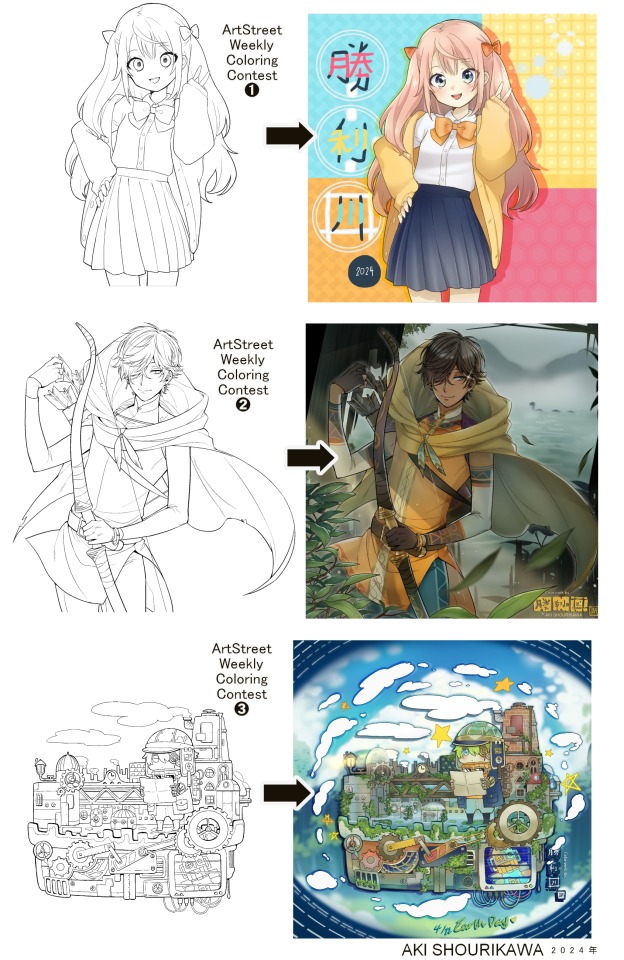
Blog No.003🍊 24年5月10日
「Let's Talk About Coloring+Rendering!!」
~ The Chaos of Akehhh-style Layering w/ Colors & Values ~
ArtStreet recently released some weekly coloring contests and as someone who likes joining 'em + colorwork being the absolute joyous part in drawing for me, I got really into it!! One of them somehow won and I still have the raw .mdp file of it with most of the layers unmerged... so, I thought there might be some value in sharing my chaotic coloring progress with it. There may never be an opportunity like this again...
CONTENTS:
Preface・・・・・・・・・
The Linework・・・・・・
Composition + Planning・
The Render・・・・・・・
Additional FX Tips・・・・
The Layers of Dread・・・
1. Preface
I use the free software MediBang Paint, which is made by the same folks who made the aforementioned art-sharing website, Artstreet. Although its file type extension is .mdp, it can also save as and open .psd files all the same.
If interested, you can download it on their website here! I believe it's available in both PC, Apple, iOs, and Android (also on the PlayStore). ☞And here is my google drive link of my fully rendered entry's raw .mdp file. I also included a .psd version that should be accessible with most other softwares like Photoshop, Clipstudio, etc.
NOTE: Not sure how some layer effects will be displayed apart from MediBang though (either in name or function) . But I think "multiply" and "overlay" is fair game on most drawing/photo-editing softwares with layer systems.
Either way, ↑this is just a bonus thing if you wish to see for yourself how much my MediBang cries everytime I work on something, since visuals of the rough step-by-step will be provided here as well!
At the end of this post, all of the layers' purposes will be explained...y-you'll see...
■And just as a disclaimer: I'm an instinctively self-taught illustrator who is a heavy visual learner, so there are certain methods I do that I cannot readily explain with back-up studies on color theories or formally taught techniques in art schools and the like/certain made-up terminologies that may or may not exist as something else. I mostly operate on instinct, observation, subjective preferences, and vibes, so this would just be me trying to verbalize my process (with visual aid) as a means of share-rambling, rather than actually directly "teaching" anything, I think haha You can take it as a cautionary tale too, honestly-
※I will also be going through this with the assumption that the reader has some background knowledge on digital illustration and general drawing basics + lingo. If you have any questions or needed clarifications, please feel free to let me know!
Although art can be fundamentally "wrong" when it comes to achieving certain specific styles, structures (especially when involving realism as the standard), or general executions of intentions/themes, I am of belief that there is generally no wrong or right 'way' for drawing anything; or for doing ANY type of artistic endeavor for that matter. This might be perceived as a "bad anatomy defender" / "no need to improve, then" stance on my part, but it is absolutely not the case! An artwork is never finished, there's always room for improvementsーa galaxy's size of a room especially for myselfーbut I just think anything at all that brings you an expressive or creative outlet, joy, or peace of mind is worth pursuing, regardless of your own skill or tact and there's no shame in that. I do not wish anyone, especially people starting out with drawing to be discouraged for having their own different approaches in comparison to other people's works by misconception of, "oh, am I doing it wrong?". Sometimes having different or an uncommon worldview is not always a 'bad' thing, I think. Heaven forbid artists actually start getting creative and unique―
What I will be presenting here is simply my one way out of thousands of thousands of different possibilities. So, let's start★
2. The Linework

Equally lengthy talk of lineart is probably for a later discussion, but here is the template provided by ArtStreet for the contest + what will be colored in for today.
☞The contest has since ended, but you can still download the lineart template here if you'd like!
3. Composition + Planning
The contest rules said it's "OK to draw backgrounds", so let's go!!
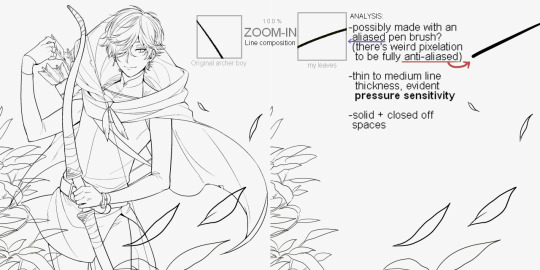
I had already decided on how I want to color it early on: It will be more scenic in nature, rather than stylistic. So, there will be more focus on looking 'real' than 'aesthetically stylish'! Just so it doesn't look disconnected or too out of place, I tried to draw my additions similarly to how Mr. archerman's linework looked as much as possible.

This how I visually define "scenic" VS "stylistic" illustrations (in my head)
I like experimenting and mixing different rendering techniques with varying linework styles and tend to think about my approach with the rendering long before the coloring process, even waaay before I line my final sketch, usually. But for this, I'm simply working with what was given to me.
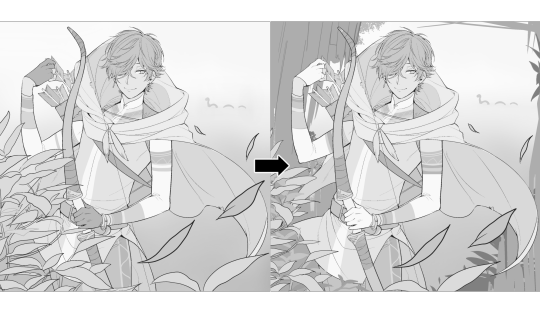
At first, I just wanted a "cool breeze w/ leaves flying away ahhhh refreshing~~" mood, but the space at the side of his head looked rather empty as is, even with Nessie. So I thought about putting him inside a vague...darkly-lit abandoned ruins-setting to eat up some of that space.
And with that, it's time for colors.
4. The Render
My coloring process is the lengthiest and often makes people who see me color in real-time scream in horror, but I think it's actually fairly simple and can be summarized into three nutshelled stages:
①Fill in the colors with a finalized palette of your choice,
②cry Continuously render until your arms fall off you're satisfied.
③ cry even HARDER (optional) Adjust accordingly to fit in better with other elements of the illustration, such as with the focus/subject to background. *will be explained later.
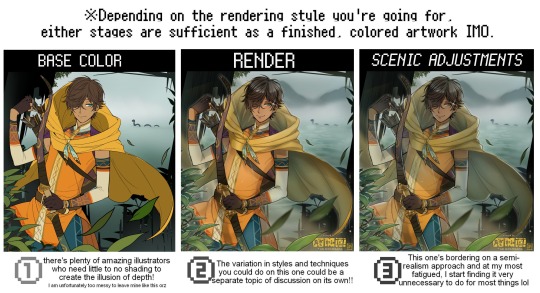
oh and btw, the usage of the words 'render(ing)' tends to be confusing with its association with other mediums like 3D models, but when it comes to drawing I like to think of it this way:
🎨Coloring is the planned/intentional selection of your color range, tints, tones, and palette to use in a drawing, ☀Rendering is the act (or product) of the set of techniques (including effects, filters, etc.) you use with the colors/values to create the illusions of depth, shadows and light, movement, warmth/cold atmospheres, etc in a 2D illustration.
But that's just how I define it with my own step-by-steps. Otherwise, I think either term is pretty much interchangeable.
Anyhoo, what do you think should this man's hair, skin, eye, and clothing's colors be?
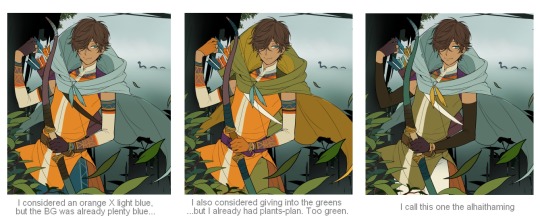
here are some of the variations on the color picks of his outfit that rotted my brain for about 3 hours straight, like it's a 2000s dress-and-match flash game
The many submissions for the contest had many fun color combinations and interesting interpretations I personally think should've won. I saw a lot of blonde archer-princes wearing greens, browns, and blues, as a lot also went for the "forest hunter boi" vibe. But I was saddened by the lack of my favorite colors being used as the primary colorーorange and yellow. So, let's use those!!
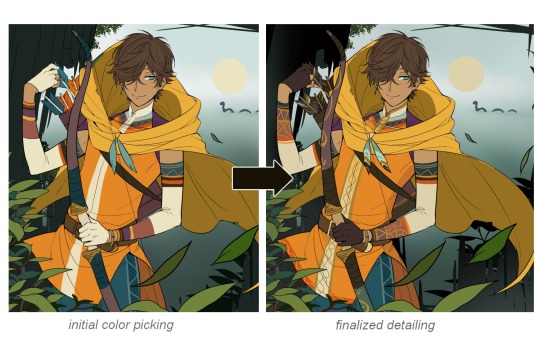
The start of my coloring/rendering journey is never at Layer '1'.........
―Starting with what I've always referred to as "environment prep":

The purpose here is to 'set' the base colors so they match with the environment or general atmosphere. Get ready to see this over and over
This could mean adjusting the saturation, or spraying gradients of the BG's most prominent color on parts that...gives me anxiety the most-
As someone who tends to work with very, very bright color schemes with character designs, trying to blend in when the illustration is meant to be scenic or 'serious' in tone without it being a distracting eyesore can be a challenge. So, this is what I do to counter it.

Shading is usually an early step for me as well, even though I think it's a lot of other artists' near-to-final step. I tend to lean towards an abomination mix of soft shade and cel shadeーthe strokes are sharp enough to trace where the shadows start and end, but softened around the edges for effect.
I also tend to apply an additional spray of subtly darker shade on top of the first one? It's usually on spots where I think the light source won't be hitting as much. I wouldn't do this for simple styles (stylized illustrations like with a chibi style), but for scenic illustrations I find it's necessary to achieve that depth against a fully-rendered environment.

※Just a side note: You may see multiple things changing around, but in real time I'm most definitely working on one part at a time lol. These visual aids were ripped off the raw .mdp by hiding some of the layers, so that's why different areas seem to progress together all at once, even if that's a bit idealistic in actuality.
Apart from the previous adding of shades with a multiply-mode layer for the preliminary shadows, I add one more layer of shadow on there for objects or other characters that can cast distinct shadows on the subject. In here, it's the bow and the hovering strap across his chest.
Lighting is also starting to be added as well.

One direct alteration I did with the lineart template was change the line's colors. I find it really softens them to mix better with their filled-in colors + as well as not stand out too harshly against a light-colored scenic background.

I think you now have a good idea over my hyperfixation on making sure colors are 'vibing' well against the BG lol A lot of these steps are basically just doing the same thing over and over with new layers for the sake of this purpose, really.
And after that, just repeating all the stuff we did with the character onto everything else (background, foreground, objects, etc.) until you're satisfied with it!


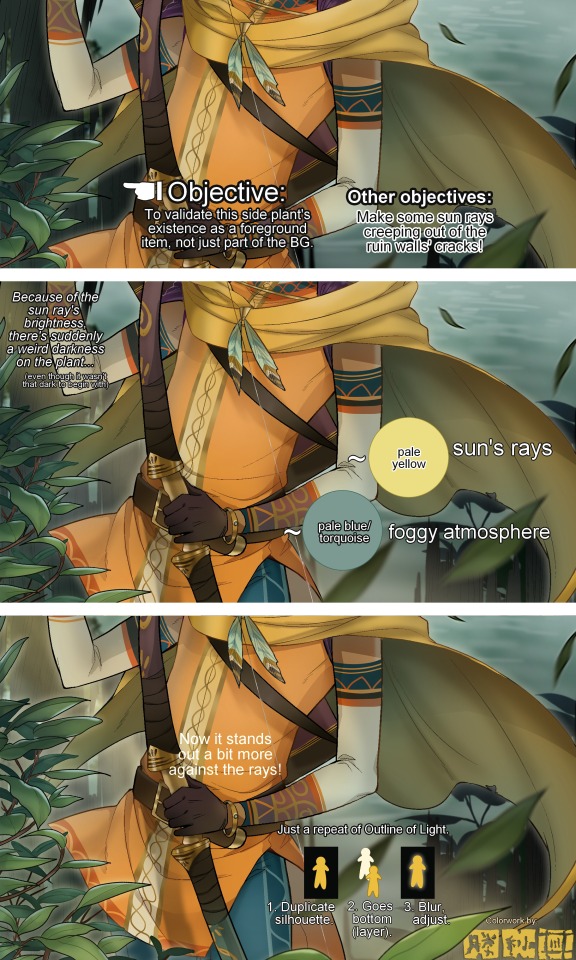
A lot of these changes are very subtle on their own, but makes all the difference in the bigger picture, I think!
Just maybe some additional finishing touches for some boom shakalaka and...that's pretty much it! You will notice that throughout the entire process, there's a lot of random little things that suddenly appear or change with seemingly not much purpose or meaning on its own. I unfortunately have always drawn in this sort of vague, quickly impulsive, directionless way since I was a child and I don't think even I will ever understand it, logically. It's mostly a... continuous string of instinctive feelings of "HEY let's do it this way, if not there's like 10 other things we can try next", is the closest I can get to an explanation of how it feels.
I don't know if it's common for other artists to think or function this way, but I do know for a fact that many people seem to be surprised and confused when they see me drawing in real time this way. Everytime I get asked 'how' I draw certain things, I say things like 'I turn my brain off and vibe with many, many layers with a broken back.' and people think it's just a dismissive joke. I-it's really not, it's literally what happens, I don't have any secret shortcuts for you-
Hopefully this very lengthy post + visual aids can help demystify some misconceptions on what "really" goes on when I'm drawing! It's also a bit of an update of my tutorials made for friendos starting out with digital drawing back in 2015!
Anyway, the rendering stage is where the simplified steps ② and optional step ③ branch out like a fork in the road for me; I don't think one is any "better" than the other, I think doing either is simply a matter of personal preference and artistic choice;
➋being leaving all that 100++ layers rendering that we just did alone and calling it a day,
➌being a little bit more extra w/ additional shadows/lighting that corresponds with the environment the character is in.

I removed the walls to see the whole figure better in a side-by-side comparison. I like the unadjusted (L) without the wall, but with the walls in the final illustration, I think adjusted (R) felt 'right'. What do you think?
There are some things, although realistic, don't look that good as a visual aesthetic and are just downright excessive/unnecessary to add to certain types of illustrations.
Then there's things that aren't possible in real life, but artistically? Looks really dang cool. Being biased for either ends of the hyperrealism and hyperstylized spectrums of styles is fine; only as long as no discrimination is involved towards people who don't share your opinions, in my opinion-
and to conclude this section, I say,
『 You go render however you wantーhellーno colors even necessary if you wish!
Simple ≠ laziness, just as much as complexity ≠ skill。』
I will never stop yapping about how a lot of minimalist styles require so much more amounts of planning and effort to make sure everything is nice and clean, especially compared to mindless rendering loops like these. Mine's a maximalist hell and I wouldn't have it any other way, but I greatly envy minimalist artists that can render with just something like my step ① with so much grace and tact; not a single stray or wasted stroke!! Anyone who dismisses these types as "lazy" I will violently stuff inside a couchーwithout any potato snacks to snack on!!!
5. Additional FX Tips
Just a shorter section for some optional finishing touches tips'n'tricks used in this I frequently (ab)use☆
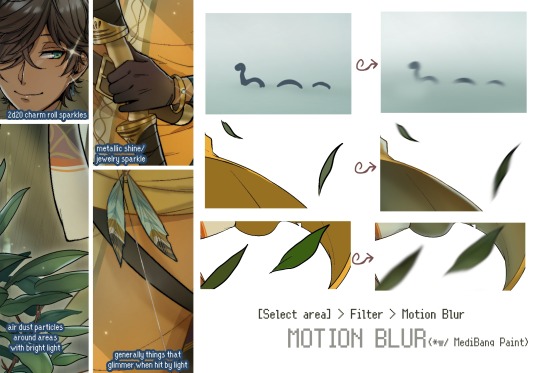
◆ From the very beginning, even before I understood how to draw, it's always been a tradition to doodle around sparkles all around the place. I usually do it with MediBang's sparkle brush if I want it to look polished, or simply draw it manually using either the pen or airbrush tool for a cruder charm.
◆ Motion blur is great, and MediBang in particular also has different types of blur effects like Gaussian and regular blurs. If your software doesn't have these effects / if you're working traditionally but still want to achieve the illusion of motion in a still drawing, you can still achieve the same effect through your linework! Try looking into incorporating action lines (commonly seen in manga and comics) into it. Otherwise, purposefully drawing something blurily to begin with oughta work as well.
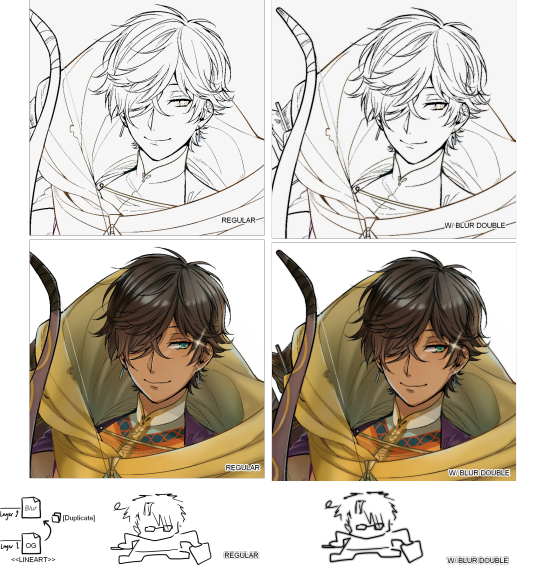
◆ Apart from changing the lineart's colors, there's also this little effect that is achieved by duplicating the lineart and blurring it. It gives something like a...'dreamy' quality to it? The higher the blurred copy's opacity is, the more emphasized it makes everything look.
6. The Layers of Dread
At long last we've arrived... at my MediBang's repeating demise for all of eternity...
Here's a preview of what the .mdp/.psd file of this colored entry's unhingedmerged layers looks like + how I try to validate their existence. When I work on full-sized illustrations, I tend to merge layers as I go, so this is probably one of the rare times I can show something like this without either mine or your PC dying. If you'd like to see, play around with, and toggle them for yourself in all of its............glory, feel free to download it here.
Yes
we're starting at Layer 611. Enjoy.
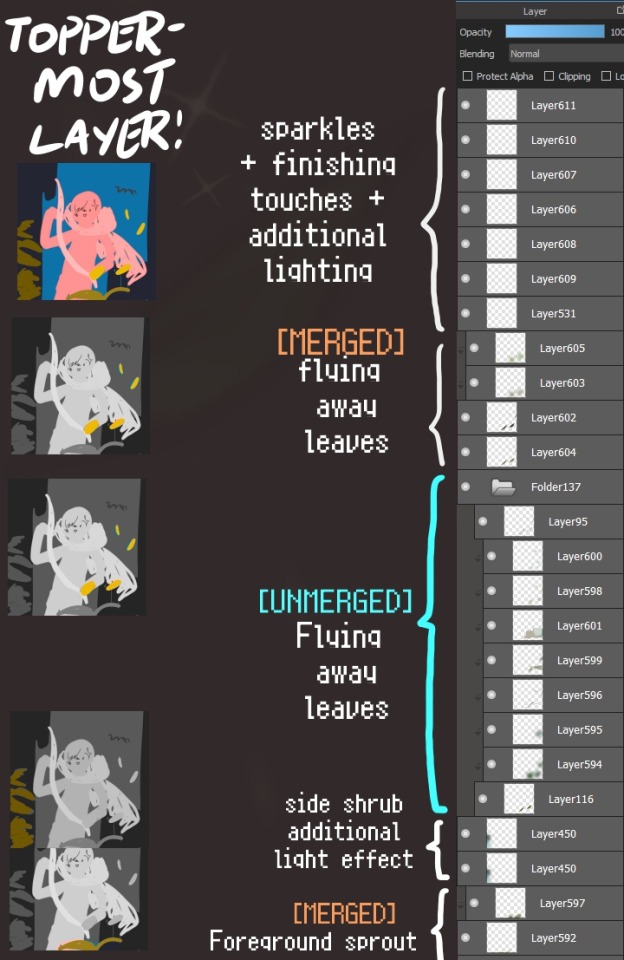
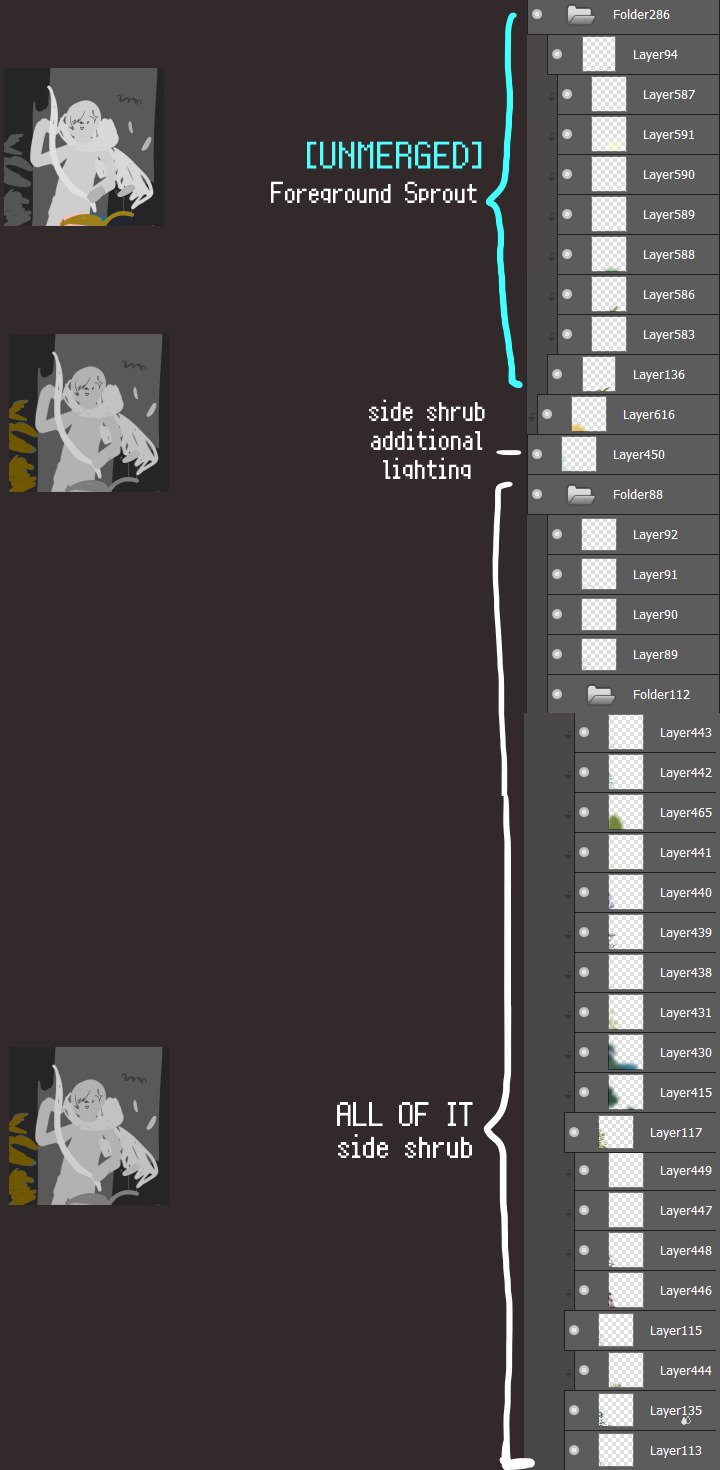
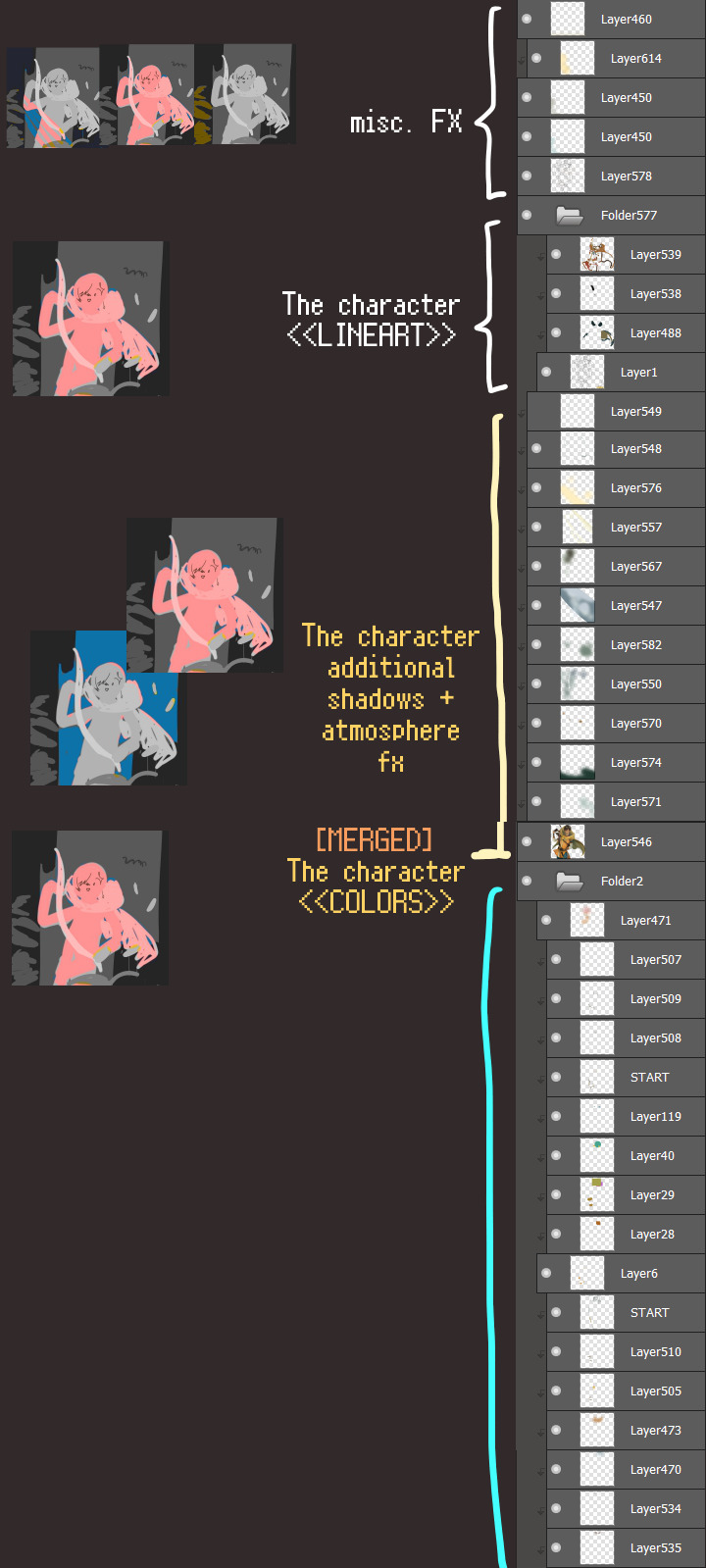
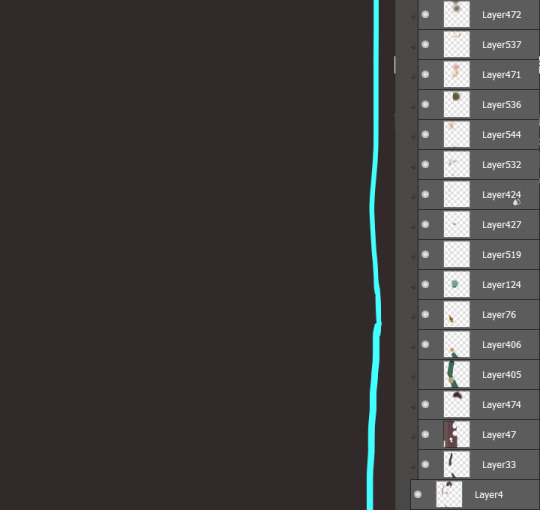
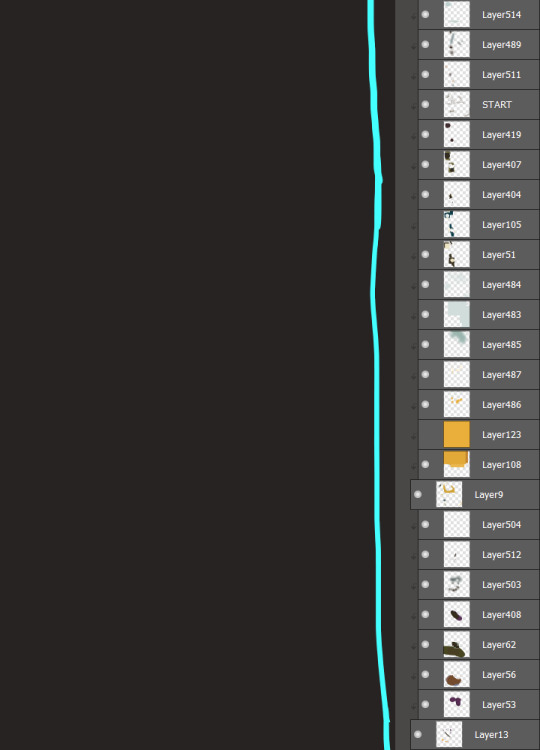
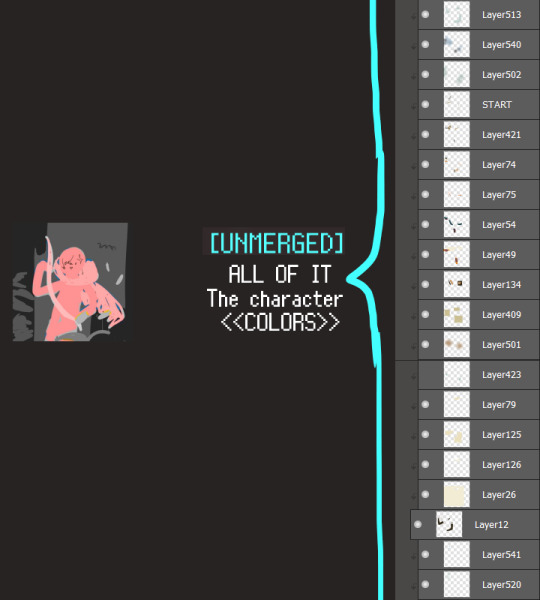
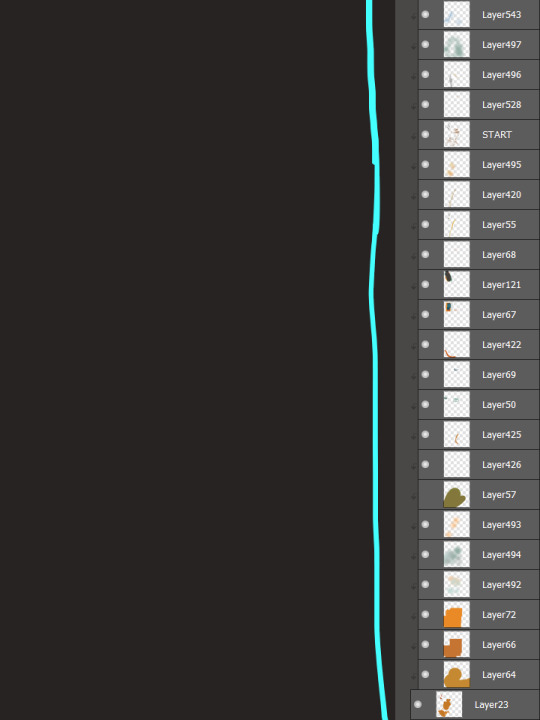
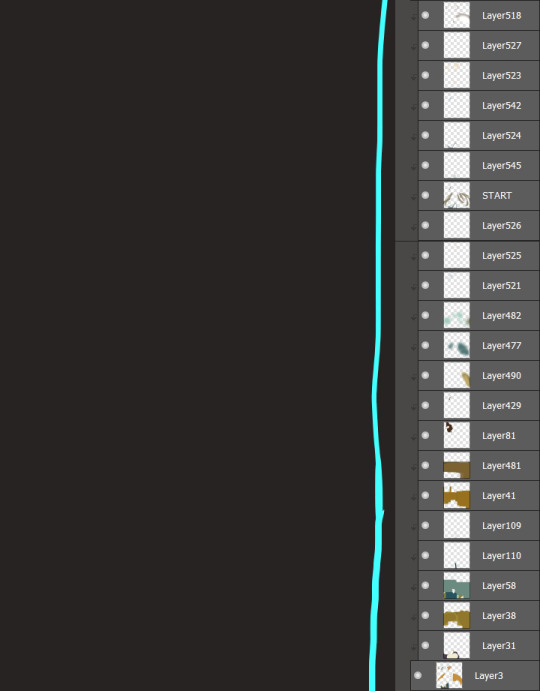
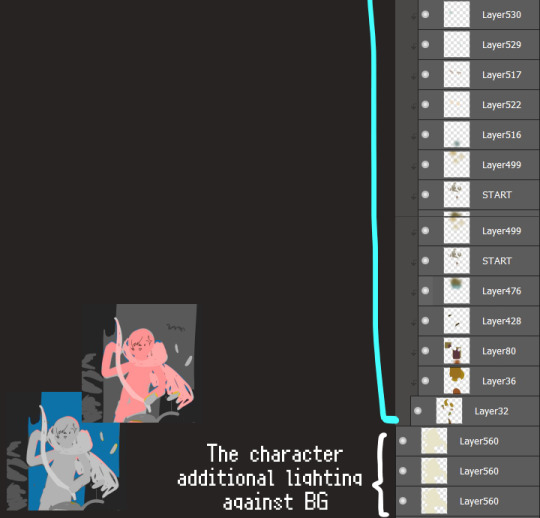
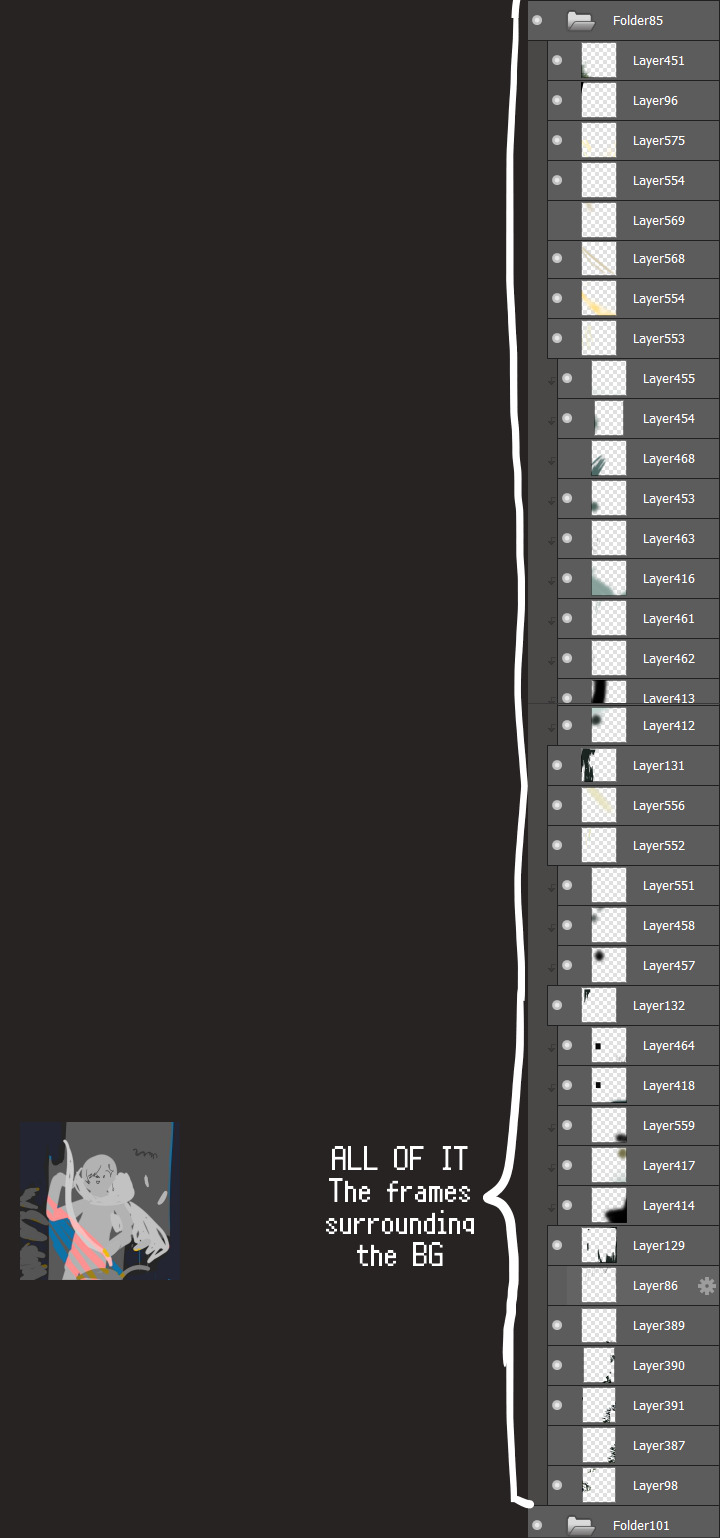
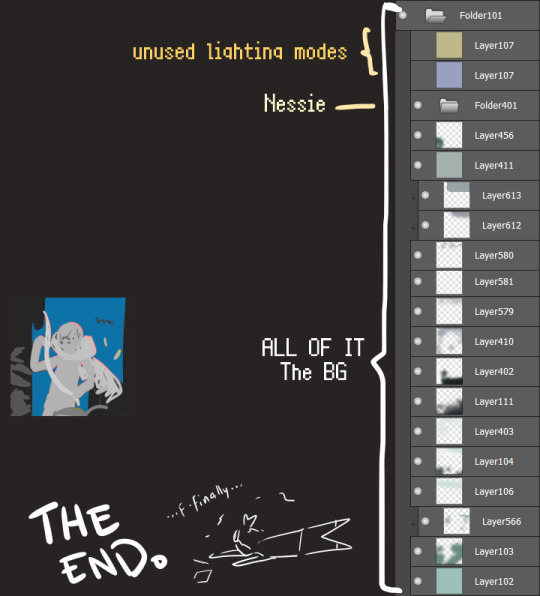
I will now delete my PC's copy because jfc that's one too many MBs ...and it's still eons lighter than what I usually work with on my own full illustrations from sketch to finish......。 (;´༎ຶٹ༎ຶ`) thank you for reading this far and making it out alive, goodbye for now...
・・・ホームページALL LINKS・・・
・Art Gallery・Commission Info・Ko-fi shop・
#art blog#long post#coloring#coloring tutorial#art tips#art tutorial#digital art#digital illustration#digital drawing#digital art tips#digital art tutorials#medibang#drawing journal#drawing process#illustration#coloring practice#nessie#the loch ness monster
30 notes
·
View notes
Text
ok as a non-native i don't know if i'm allowed to say this to y'all, but i think i've had enough
"too" at the end of a sentence does not always need a comma. you're not smarter for adding the comma if you don't know why you're putting it there. please, it's best to lack it than to overdo it.
now, for the grammar lesson:
When you DO need that comma:
A: "I like pizza. I like ice cream, too."
If the object of the first sentence (pizza, in this case) is different from that of the second one (ice cream), you use a comma. Those objects can be Direct Objects, Verbs (actions), Subjects, Places... Anything, really.
A: "I am walking. I am singing, too."
Different objects. Actions, this time. (Aka: Verbs)
When you DON'T need that comma:
A: "I like pizza."
B: "I like pizza too."
If the object is the same in both sentences, you use a comma. This "too" often refers to the exact same action being done by a different subject.
"Me, too." IS NOT RIGHT. GOOGLE SAYS IT IS, BUT IT IS NOT. (Except very specific scenarios.)
A: "I am gay."
B: "Me, too."
That would mean "You are gay, and you are also me." So, yes, the comma might be needed in some context, but not always. Not in this one, I hope.
A: "I am gay."
B: "Me too."
In this second example, what is implied is that the second speaker is also gay and they can both make out or whatever people do.
There is a pretty huge difference, in my humble opinion.
Easy tricks to tell these two scenarios apart:
1. Always have clear what the context is. This might sound obvious but, if you're not sure what punctuation to use, consider first what you want to say, what that "too" is referring to and why it's there.
2. In your head, you can rephrase the sentence so that the "too" is at the beginning of it (after the Subject). If the sentence makes sense, then the original (the version with the "too" at the end) must not use a comma.
Some examples, in case that last bit made no sense to you:
(Disclaimer: I don't know if this tip always works, but it certainly does most of the time, so I suggest you use it in case of doubt.)
A: "I am walking too."
NO COMMA. This implies that the speaker is not the only one walking, so there is another different subject executing the exact same action. They might be talking to someone who is walking alongside them.
A: "I am walking, too."
COMMA. This implies that the speaker is not only walking, but executing a different action at the same time. They might be walking while listening to music, speaking, singing...
A: "I, too, am walking."
"TOO" BETWEEN S. AND V. This sentence can be taken as identical to the NO COMMA option, since the function of the "too" is to make a reference to the speaker, and them not being the only one executing the action.
You can also use "too" between the Subject and Verb to express what a sentence WITH comma does (same Subject, different Verbs or Objects), but that is rarely used, so, personally, I don't recommend it. Anyway, you are totally free to use "too" in that way! It's your writing, experiment with it. It just sounds odd to me.
3. Look it up! You've got Google, I'm sure a lot of web pages have the answer to your question. Plus, online forums exist; WordReference has a pretty decent one. Seriously, don't be afraid to ask!
You will probably get different views and opinions on how commas must be used in this or other contexts, but that's not bad, it just means you have to understand and form your own system through your writing. Always seek to learn; language is not math, it's art. Yes, even your boring ass college papers.
NOW, GO IMPROVE YOUR FANFIC WRITING. THANKS. I LOVE YOU.
i genuinely hope that helped lmao
#i already warned you i am a huge grammar nerd sorry#now fr educate yourselves everyone#grammar#commas#writing#how do you even tag this#bee is a nerd#bee writes#ig? idk#know you commas kids
5 notes
·
View notes
Text
Strategies for Building Lasting Habits
Building lasting habits and improving executive function is all about creating systems that work with your strengths.

In a recent article from ADDitude Magazine,How to Forge Stick-with-It Habits, Peg Dawson, EdD, shares valuable strategies to use executive functioning skills and build good habits. Here are a few quick tips, inspired by her article, to help you get started:
1. Use External Reminders to Ease Memory Load: Leverage tools like phone alarms, sticky notes, or calendars to help you remember tasks. These external reminders reduce mental strain and free up your memory for other important things. 2. Start Small and Build Momentum: Begin with simple, achievable goals (i.e., a daily 10-minute walk if you're aiming to exercise more). This allows you to build consistency and gain momentum over time. 3. Make It Easy to Get Started: Remove obstacles to getting started. For example, if you want to read more, keep your book on your nightstand to make it easy to pick up before bed. 4. Track and Celebrate Progress: Recognize your small victories and reward yourself along the way. Monitoring your progress reinforces positive behavior and boosts motivation.
While forming habits, it is important to implement strategies to conserve energy rather than relying solely on willpower. For example, minimizing distractions—such as silencing your phone or using noise-canceling headphones—can help you stay focused. Designating separate spaces for work, relaxation, and hobbies allows your mind to easily associate each area with its purpose, making it easier to concentrate. Additionally, partnering with someone for accountability can offer valuable motivation and support.
By applying these strategies, you can begin building healthy habits that support long-term success.
I also encourage you to explore these tools to promote your well-being:
Empowerment Through Understanding Modules: Dive deeper into ADHD and Autism with this online course to improve self-awareness, self-advocacy, and personal growth. Learn more here.
AuDHD Strong App: A helpful app for neurodivergent individuals with tools for organization, task management, and self-care. Download it today from the App Store or the Google Play Store!
Faces of Health App: This app offers valuable mental health and well-being resources. Download it today from the App Store or the Google Play Store!
For more valuable insights, I encourage you to explore my blog at https://drblied.com/blog/. For a selection of wellness resources, please visit the resources page on my website at https://drblied.com/resources/.
Reference
Dawson, P. (2025). How to forge stick-with-it habits. ADDitude Magazine. https://www.additudemag.com/building-healthy-habits-executive-functioning-skills-adhd/
#HabitBuilding#ADHDSupport#ExecutiveFunctioning#Motivation#ADHDSuccess#PositiveChange#DrBlied#MentalHealth#Psychology#TherapySkills#Education#Neurodivergent#Neurospicy#Neurodiverse#ADHD#Autism#AuDHD#ForYou
2 notes
·
View notes
Text
How to Master the Dumbbell Chest Fly for Maximum Chest Growth
The dumbbell chest fly is a highly effective isolation exercise that enhances chest development, improves flexibility, and strengthens the pectoralis major and minor. While it may seem simple, mastering the correct form and technique is essential to maximize muscle engagement and prevent injuries. This guide will take you through everything you need to know to perfect the dumbbell chest fly and make it a powerful addition to your workout routine.
Why the Dumbbell Chest Fly?
The dumbbell chest fly is a great complement to pressing movements like the bench press. Here’s why it should be a staple in your chest workouts:
✔ Targets the Pectoral Muscles: It stretches and contracts the chest, leading to enhanced muscle growth. ✔ Improves Chest Definition: Helps create a broader, more sculpted chest. ✔ Enhances Shoulder Stability: Works the stabilizer muscles in the shoulders, improving overall strength. ✔ Increases Range of Motion (ROM): Encourages flexibility and a greater stretch, essential for muscle activation. ✔ Reduces Joint Stress: A good alternative to heavy presses that put strain on the shoulders.
Step-by-Step Guide to Performing the Dumbbell Chest Fly
Step 1: Set Up Properly
Choose a flat bench and grab a pair of dumbbells that allow controlled movement.
Lie flat on the bench with feet planted firmly on the ground.
Hold the dumbbells directly above your chest with a slight bend in your elbows.
Your palms should face each other.
Step 2: Controlled Descent (Eccentric Phase)
Slowly lower the dumbbells outward in an arc, keeping a slight bend in your elbows.
Lower the weights until your chest feels a deep stretch (your elbows should be at chest level).
Maintain control and do not let your arms drop too low to prevent shoulder strain.
Step 3: Powerful Contraction (Concentric Phase)
Squeeze your chest muscles and bring the dumbbells back to the starting position.
Keep the movement controlled and avoid clashing the dumbbells together.
Focus on engaging your chest, rather than using your arms or shoulders.
Step 4: Repeat with Proper Form
Perform 3-4 sets of 10-12 reps.
Maintain slow and controlled movements to maximize muscle activation.
Rest 30-60 seconds between sets to keep intensity high.
Common Mistakes to Avoid
🚫 Using Too Much Weight: Stick to moderate weight to maintain good form and avoid injuries. 🚫 Overextending the Arms: Keep a slight bend in your elbows to protect your shoulder joints. 🚫 Rushing the Movement: Slow and controlled reps are key to maximizing chest activation. 🚫 Engaging the Arms Too Much: Focus on your pectorals, not just your arms. 🚫 Arching the Lower Back: Keep your back flat on the bench to prevent strain.
Variations to Maximize Your Chest Growth
✅ Incline Dumbbell Chest Fly – Targets the upper chest, improving overall muscle balance. ✅ Decline Dumbbell Chest Fly – Emphasizes the lower chest, adding shape and definition. ✅ Cable Chest Fly – Maintains constant tension, leading to improved muscle engagement. ✅ Standing Dumbbell Fly – Works the chest in an upright position for functional strength.
Pro Tips for Maximum Gains
🔥 Use a Full Range of Motion: Stretch your chest muscles fully for better hypertrophy. 🔥 Slow Down the Negative Phase: A 2-3 second lowering phase increases time under tension. 🔥 Contract the Chest at the Top: Squeeze your pecs at the top of each rep to enhance definition. 🔥 Combine with Pressing Movements: Incorporate bench presses and push-ups for a balanced chest workout. 🔥 Train with Progressive Overload: Gradually increase weight and reps to stimulate muscle growth.
Final Thoughts: Mastering the Dumbbell Chest Fly
The dumbbell chest fly is an essential exercise for anyone looking to build a strong, well-defined chest. When executed with proper form, controlled motion, and progressive overload, it can significantly enhance muscle growth and upper-body strength.
Start with light to moderate weights, perfect your technique, and gradually increase resistance over time. By integrating chest fly variations into your routine, you’ll develop a fuller, stronger, and more aesthetically balanced chest.
💪 Are you ready to take your chest workouts to the next level? Let’s get started! 🔥
#Dumbbell Chest Fly#How to Master the Dumbbell Chest Fly#chest fly machine#dumbbell fly#video#exercise#workout#tumblr#youtube#core workout
2 notes
·
View notes
Text
ADHD PSA #3: Bath time 🛀
So I just moved into a new house, and for whatever reason, the gremlins living in my brain have decided that the new shower has ‼️BAD VIBES‼️ and therefore will only agree to let me have a shower when ABSOLUTELY NECESSARY. I've been trying to figure out ways to bribe them into liking the shower, so here are a few ways I've tried to make my shower ADHD accessible.
1) DIY waterproof phone holder
Yes I know I sound like an iPad kid, but if having an audiobook/music/YouTube video playing while I shower lets me shower, I'm ok with that.
All you do is take a sturdy ziplock bag, pop your phone and a large bull clip inside, and zip it up tight (give it a lil squeeze to make sure there are no gaps). Now you can clip the bag onto your shower caddy from the inside, or another ledge or something (get creative), and voila - your phone stays totally dry and you stay entertained. You can even somewhat use your phone through the plastic, so you can change songs etc. When you're done, unclip the unopened bag, take it to a dry place, and you can open it and take your phone out there.
Here's a photo for demo:
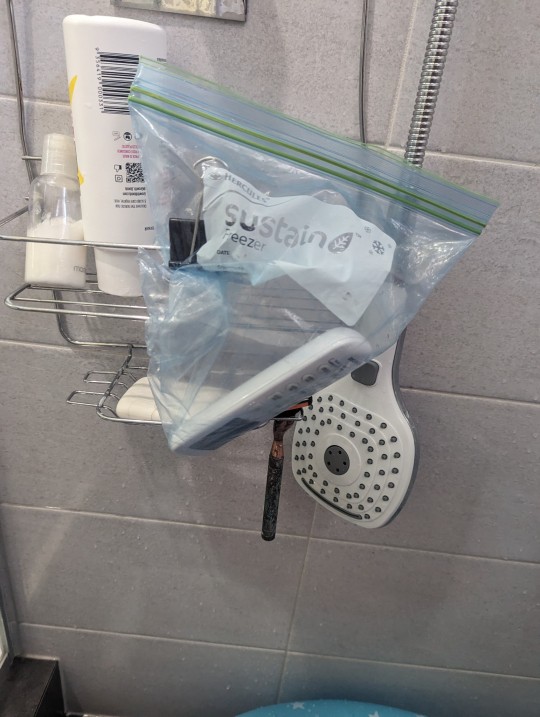
2) Sort your shit out
Personally, I get super overwhelmed by all the steps in self-care tasks, including but not limited to showers. Routines like that involve like 10 steps that call on skills ADHDers really struggle with, like decisions, organisation, memory, executive functioning, and planning. So I've made things as simple as they can possibly be for me.
I have 4 little baskets in my cupboard for each of my regular routines:
morning (with makeup, sunscreen, moisturiser, and deoderant)
evening (with vitamin C serum, makeup wipes, pimple patches, and floss)
regular shower (with antibacterial soap, shampoo, conditioner, leave in conditioner, and a hair brush)
and ✨fancy shower✨ (with a razor, shaving cream, nice smelling soap, body moisturiser, curl cream, and a candle)
Now I can just yank out whatever basket I want and use whatever is in it on autopilot. Then, when I'm done, I can dump it all back into the basket and shove it all back into the cupboard. This method reduces how overwhelmed I get by so goddamn much that my fucking dentist commented on the noticeable improvement in my teeth, because I had actually consistently had the energy to floss. And when you're consistently flossing - well, it's only up from here baby 😎
3) DIY bath
The sensory experience of showering can be truly horrendous. And while I can't fix a lot of it, I can at least make it a little less... much. Yk?
So here's my solution:
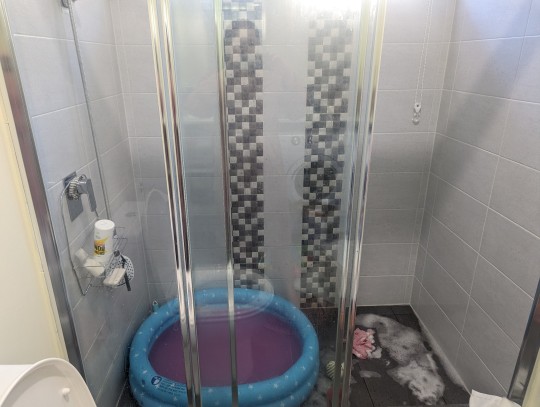
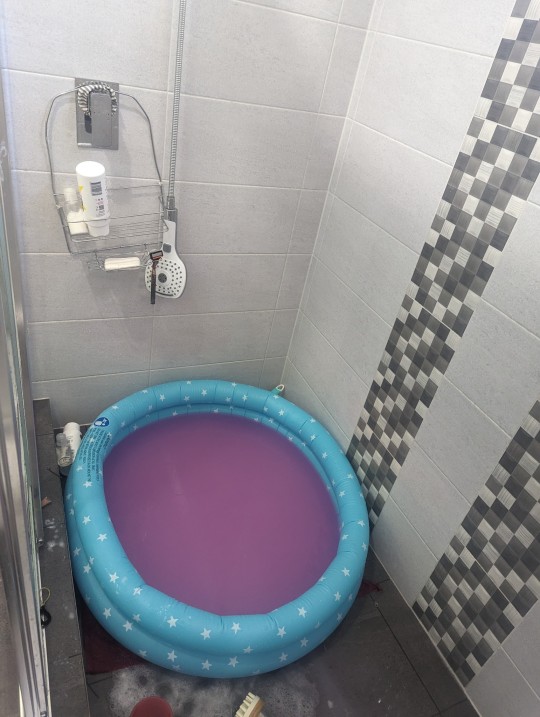
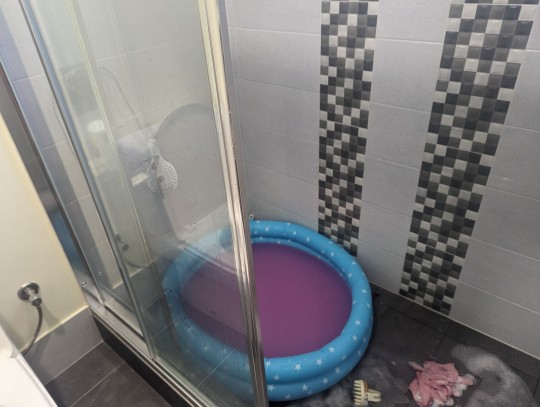
Yup.
I got myself a blow up pool.
For my shower.
I am officially the coolest person alive.
This baby was $10 at Kmart, and is 80cm wide and 18cm deep - basically, cross your legs and it will not quite cover your thighs. To provide a little more insulation and some padding, I also popped an old towel under the pool. It's really not much, but it means I can sit down in comfortably warm water and splish-splosh myself clean. As opposed to showering, which (especially in a large bathroom/shower like I have now) is alternately way too cold and way too hot, way too loud, way too (I literally don't know how else to say it) "fast", way too out of control (so much splashing and water going everywhere, UGH), and just kinda generally way too much.
A bonus perk: I can finally use some nice pink bubble bath bombs from last Christmas 🥰🥰
I really hope one of these tips helps one of you out there. Keeping yourself clean is one of those "basics" that neurotypical/mentally well people don't realise is actually really hard.
You are doing a truly awesome job, and I'm truly, truly proud of you. Sending you love and warm, clean, sudsy thoughts ❤️
#my posts#mental health#adhd#neurodivergent#womenwithadhd#audhd#autism#burnout#adhd psa#ADHD PSA#life hacks#adhd hacks
8 notes
·
View notes
Note
do u have any daily-tooth-brushing tips? i struggle with a weird mixture of demand avoidance, executive dysfunction, and, ironically!!! obsessive/intrusive thoughts bout my dental health suddenly deteriorating which youd think would make me brush them more but i got a fun sprinkle of "brushing/flossing will actually DAMAGE your teeth" irrational thoughts haha. I do try to brush/mouthwash daily regardless (and use the finch app to motivate me) & have dental appts and therapy coming up but god i wish it were easier for now lol
For me getting a fancy ass electric toothbrush was an important stepping stone to making a regular habit of brushing. They effectualize the process so that when you do brush, you're likely to brush more thoroughly, and for me they're easier to use properly, which takes some thinking and effort out of the event which definitely helps on the executive dysfunction part in my case. They're also less unpleasant sensory wise for me personally than the regular ones are, though I know this isn't universal. But for me it really helped. And beyond that it was mostly about my general mental health and functioning increasing. It unfortunately wasn't that I suddenly discovered the Secret of Brushing Daily, I just improved on a more general level
13 notes
·
View notes
Text
Google Sheets Shortcuts: Boosting Productivity with Efficient Tools
In the world of productivity tools, Google Sheets stands out as one of the most widely used spreadsheet applications. Whether you're managing a budget, analyzing data, or collaborating with a team, Google Sheets offers a variety of features that can make your work more efficient. One of the best ways to enhance your experience with Google Sheets is by mastering Google Sheets shortcuts. These shortcuts can help you save time, improve your workflow, and make your spreadsheet tasks easier to execute. In this article, we will explore a comprehensive guide on Google Sheets shortcuts, offering tips and strategies to maximize your productivity.

What Are Google Sheets Shortcuts?
Google Sheets shortcuts are keyboard commands that allow you to execute specific functions within the application without using your mouse. By learning these shortcuts, you can navigate, format, and manipulate data with ease, making your experience smoother and more efficient. These shortcuts are designed to save time by streamlining tasks, especially when dealing with large datasets.
Using shortcuts can seem intimidating at first, but once you familiarize yourself with them, you'll find that they become second nature. Google Sheets has a variety of shortcuts, from basic navigation commands to more advanced formatting and data manipulation features. Mastering these commands is essential for anyone looking to work faster and smarter.
Many of the shortcuts in Google Sheets are similar to those found in other Google Workspace apps like Google Docs and Google Slides, making it easier for users to transition between tools. However, Google Sheets also offers unique shortcuts that are specifically designed for working with spreadsheets.
Why Should You Use Google Sheets Shortcuts?
The benefits of using Google Sheets shortcuts extend far beyond just saving time. By integrating these shortcuts into your daily workflow, you can achieve the following:
1. Increased Speed and Efficiency
When working on a complex spreadsheet, every second counts. Instead of manually clicking through menus or dragging and dropping cells, shortcuts allow you to execute commands with a simple keystroke. This can significantly reduce the time spent on repetitive tasks.
2. Improved Focus
Navigating with your mouse can often interrupt your flow, especially when you need to switch between different sections of a large spreadsheet. Shortcuts keep your hands on the keyboard, allowing you to focus on the task at hand without distractions.
3. Boosted Productivity
The more shortcuts you learn, the quicker you'll be able to accomplish tasks. Whether you're entering data, formatting cells, or applying functions, shortcuts enable you to complete tasks in a fraction of the time.
4. Enhanced Collaboration
In collaborative work environments, efficiency is crucial. By using Google Sheets shortcuts, you can keep up with fast-paced team activities, making sure that everyone stays on track and productive.
Essential Google Sheets Shortcuts for Everyday Use
Whether you're new to Google Sheets or have been using it for years, there are several shortcuts that every user should know. These essential Google Sheets shortcuts will help you with basic functions, such as navigating your sheet, selecting cells, and formatting content. Let's dive into these fundamental keyboard shortcuts:
1. Navigation Shortcuts
Navigating through your spreadsheet is one of the most common tasks you'll perform in Google Sheets. Below is a list of the most helpful shortcuts for moving around your sheet:
Move to the next cell: Tab
Move to the previous cell: Shift + Tab
Move to the beginning of the row: Home
Move to the beginning of the sheet: Ctrl + Home (Windows) / Command + Home (Mac)
Move to the last cell with data: Ctrl + Arrow Key (Windows) / Command + Arrow Key (Mac)
Jump to the top of the sheet: Ctrl + Up Arrow (Windows) / Command + Up Arrow (Mac)
Jump to the bottom of the sheet: Ctrl + Down Arrow (Windows) / Command + Down Arrow (Mac)
These navigation shortcuts can save you a lot of time when you're dealing with large datasets or when you're trying to quickly locate a specific cell.
2. Selection Shortcuts
Selecting cells, rows, or columns is another task you'll do frequently in Google Sheets. The following shortcuts will help you make precise selections quickly:
Select an entire row: Shift + Space
Select an entire column: Ctrl + Space (Windows) / Command + Space (Mac)
Select a range of cells: Hold Shift, then use the Arrow Keys to extend the selection.
Select all cells: Ctrl + A (Windows) / Command + A (Mac)
Using these shortcuts will enable you to quickly highlight areas of your spreadsheet, making tasks like data manipulation and formatting much faster.
Advanced Google Sheets Shortcuts for Power Users
While basic Google Sheets shortcuts are essential for day-to-day tasks, advanced users can take advantage of more specialized shortcuts to streamline their workflow. These commands are designed for users who want to go beyond the basics and truly optimize their experience in Google Sheets. For more advanced techniques and automation, check out the Google Sheets Scripting Guide.
1. Editing and Formatting Shortcuts
Editing and formatting your data quickly is key to working efficiently in Google Sheets. The following shortcuts allow you to perform various editing tasks without taking your hands off the keyboard:
Bold text: Ctrl + B (Windows) / Command + B (Mac)
Italicize text: Ctrl + I (Windows) / Command + I (Mac)
Underline text: Ctrl + U (Windows) / Command + U (Mac)
Open the format menu: Alt + Shift + F (Windows) / Option + Shift + F (Mac)
Open the data menu: Alt + Shift + D (Windows) / Option + Shift + D (Mac)
2. Data Manipulation Shortcuts
Manipulating and managing data efficiently is one of the greatest advantages of Google Sheets shortcuts. These commands will help you perform data operations faster:
Undo an action: Ctrl + Z (Windows) / Command + Z (Mac)
Redo an action: Ctrl + Y (Windows) / Command + Y (Mac)
Insert a new row: Alt + Shift + I, then press R
Insert a new column: Alt + Shift + I, then press C
Delete a row: Alt + E, then press D
Delete a column: Alt + E, then press K
Mastering these shortcuts allows you to handle large datasets with more control and precision, reducing the need for manual intervention.
Customizing Google Sheets Shortcuts for Personal Use
While the default Google Sheets shortcuts are quite helpful, you might want to create a custom set of shortcuts that align better with your workflow. Fortunately, Google Sheets allows you to customize certain keyboard shortcuts, helping you tailor the tool to your specific needs. For more tips and tutorials, check out over blog.
To customize Google Sheets shortcuts, follow these steps:
Go to the Google Sheets Settings: Open Google Sheets and click on the gear icon in the top right corner.
Select "Keyboard shortcuts": This will open a menu where you can view and modify your existing shortcuts.
Edit your shortcuts: You can change the key combinations for specific commands or add new ones to suit your needs.
Customizing your shortcuts can be particularly useful for users who perform repetitive tasks or need to execute specific commands more frequently. By adjusting the shortcuts to match your workflow, you can enhance your productivity even further.
Google Sheets Shortcuts for Collaboration
Collaboration is one of the core features of Google Sheets, and mastering Google Sheets shortcuts can significantly improve your ability to work with teams. Whether you're adding comments, sharing the sheet, or assigning tasks, these shortcuts will help streamline your collaborative efforts.
1. Commenting and Reviewing
In team environments, adding comments and reviewing content quickly is essential. These shortcuts will help you add comments or switch between them:
Insert a comment: Ctrl + Alt + M (Windows) / Command + Option + M (Mac)
Open the comments thread: Ctrl + Alt + Shift + A (Windows) / Command + Option + Shift + A (Mac)
2. Sharing and Collaborating
When you need to share or collaborate on a Google Sheet with others, the following shortcuts come in handy:
Open the sharing settings: Ctrl + Shift + S (Windows) / Command + Shift + S (Mac)
Share the sheet with others: Ctrl + Shift + E (Windows) / Command + Shift + E (Mac)
These shortcuts allow you to engage in real-time collaboration, making it easier to share your work with others and communicate effectively.
Conclusion: Mastering Google Sheets Shortcuts for Maximum Efficiency
In conclusion, mastering Google Sheets shortcuts is an essential step in improving your productivity and efficiency. By learning both basic and advanced shortcuts, you can navigate your sheets faster, manipulate data more efficiently, and collaborate seamlessly with others. Whether you're a beginner or a power user, these shortcuts will help you make the most out of your Google Sheets experience. For more tips and resources, visit at http://workflows.gsheetmaster.com/.
Remember, practice makes perfect. The more you use these shortcuts, the more natural they will become, allowing you to focus on the tasks that matter most. Stay updated with the latest in Google Sheets through the GSheetMasters blog. Explore tips, tutorials, best practices, and expert insights to enhance your spreadsheet skills and productivity.
youtube
1. What are Google Sheets shortcuts?
Google Sheets shortcuts are keyboard commands that allow you to execute specific functions within the spreadsheet application without using your mouse. These shortcuts help streamline tasks, such as navigating cells, formatting data, and manipulating content, enabling faster and more efficient work.
2. How can I learn Google Sheets shortcuts?
To learn Google Sheets shortcuts, you can start by exploring the built-in shortcuts that Google Sheets offers. You can access a list of these shortcuts by pressing Ctrl + / (Windows) or Command + / (Mac). There are also many tutorials, guides, and blogs available online that provide comprehensive lists and tips for mastering these shortcuts.
3. Can I customize Google Sheets shortcuts?
Yes, Google Sheets allows you to customize some of the shortcuts to better suit your needs. You can modify existing shortcuts and add your own by going to the Keyboard shortcuts section in the settings. This can help you create a workflow that is more tailored to your personal preferences.
4. What is the most useful Google Sheets shortcut for data navigation?
One of the most useful Google Sheets shortcuts for navigation is Ctrl + Arrow Keys (Windows) or Command + Arrow Keys (Mac). This shortcut allows you to quickly jump to the last cell in the direction of the arrow, making it easier to navigate large datasets without scrolling.
5. Are there shortcuts to help with formatting in Google Sheets?
Yes, Google Sheets offers several formatting-related shortcuts. Some common ones include:
Ctrl + B (Windows) / Command + B (Mac) to bold text
Ctrl + I (Windows) / Command + I (Mac) to italicize text
Ctrl + U (Windows) / Command + U (Mac) to underline text
These shortcuts help you format your spreadsheet content quickly, without needing to use the toolbar.
6. How do I select an entire row or column using shortcuts?
To select an entire row, press Shift + Space. To select an entire column, press Ctrl + Space (Windows) or Command + Space (Mac). These shortcuts allow you to select large sections of your sheet in just one keystroke, saving you time when working with extensive data.
7. Can I undo or redo changes in Google Sheets using shortcuts?
Yes, you can easily undo and redo changes in Google Sheets using shortcuts. The shortcut Ctrl + Z (Windows) or Command + Z (Mac) undoes the last action, while Ctrl + Y (Windows) or Command + Y (Mac) redoes it. These commands help you quickly correct mistakes or redo actions without navigating through the menus.
8. What is the shortcut to insert a new row or column in Google Sheets?
To insert a new row in Google Sheets, press Alt + Shift + I, then R. For a new column, press Alt + Shift + I, then C. These shortcuts allow you to add rows and columns quickly without needing to use the context menu.
9. How do I open the sharing settings in Google Sheets using a shortcut?
To open the sharing settings in Google Sheets, you can use the shortcut Ctrl + Shift + S (Windows) or Command + Shift + S (Mac). This allows you to quickly access the sharing options and manage permissions for your spreadsheet.
10. Are there any shortcuts for working with comments in Google Sheets?
Yes, Google Sheets has shortcuts for adding and navigating comments. To insert a comment, use the shortcut Ctrl + Alt + M (Windows) or Command + Option + M (Mac). To open the comments thread, use Ctrl + Alt + Shift + A (Windows) or Command + Option + Shift + A (Mac). These shortcuts make it easy to collaborate and communicate with team members in real time.
Follow Us Blogger | Twitter | Gravatar | Disqus | Google Sites | Youtube | About.Me
2 notes
·
View notes
Text
Singapore’s Best Wood Decking Installation | RSR Engineering

We offer high-quality wood decking installations at affordable prices. Trust RSR Engineering for durable, stylish decking solutions. Contact us today.
Enhance Your Outdoor Space with Wood Decking: A Guide by RSR Engineering Singapore:
In Singapore’s warm, tropical climate, outdoor living spaces are an extension of our homes. A beautifully designed deck not only enhances the aesthetics of your outdoor area but also adds functionality and value to your property. At RSR Engineering, we specialize in crafting premium wood decking solutions tailored to your needs.
Why Choose Wood Decking?
Wood decking offers unparalleled beauty and durability, making it an ideal choice for residential and commercial spaces. Here are some reasons why it’s a popular option in Singapore:
1. Natural Aesthetic Appeal:
Wood decking provides a warm and timeless look, blending seamlessly with natural surroundings. It’s perfect for balconies, and poolside areas.
2. Durability in Tropical Climates:
High quality hardwoods, like teak or chengal, are highly resistant to moisture, pests, and UV rays, ensuring long-lasting performance in Singapore’s humid weather.
3. Versatile Design Options:
Whether you prefer a sleek modern style or a rustic charm, wood decking can be customized to complement your outdoor design vision.
4. Sustainability:
Many wood decking options come from sustainable sources, making it an eco-friendly choice for conscious homeowners.
Why RSR Engineering?
As a leading provider of home improvement services in Singapore, RSR Engineering prides itself on quality craftsmanship and customer satisfaction. Our experienced team ensures every project is executed with precision and care, delivering results that exceed expectations.
Our Wood Decking Services at RSR Engineering:

1. Custom Design and Installation:We collaborate closely with clients to design and install wood decking that meets their unique requirements. From small patios to expansive decks, no project is too big or small.
2. Deck Maintenance and Restoration:
Keep your decking looking fresh with our polishing and refinishing services. Our team ensures your wood remains smooth, safe, and visually appealing for years.
We use sustainable wood materials and non-toxic finishes to ensure minimal environmental impact.
Essential Tips for Wood Decking by RSR Engineering Singapore:
Wood decking can elevate your outdoor spaces with its natural beauty and durability. To ensure your deck remains stunning and functional for years to come, consider these expert tips from RSR Engineering.
1. Choose the Right Type of Wood
Not all woods are created equal. Select a durable hardwood suitable for Singapore’s tropical climate. Popular choices include:
Chengal: Highly durable and resistant to decay.
Teak: Premium, weather-resistant wood with natural oils that repel water and pests.
Merbau: Affordable and sturdy, with a rich, dark finish.
2. Prioritize Quality Installation
Proper installation ensures the longevity of your deck. Partner with experienced professionals like RSR Engineering for precise measurements, secure fastenings, and optimal spacing to prevent warping or water pooling.
3. Opt for a Protective Finish:
Apply a sealant or finish to protect your decking from moisture, UV rays, and pests. Choose finishes that enhance the wood's natural beauty, such as:
Oil-based finishes for a glossy look.
Water-based finishes for a matte appearance and low VOC levels.
4. Maintain Regularly:
Regular maintenance helps keep your deck in top condition:
Clean Weekly: Sweep debris and wash with a mild soap solution to prevent mold growth.
Inspect Annually: Check for signs of rot, cracks, or loose boards and address issues promptly.
Reapply Sealants: Refinish every 1-2 years to maintain protection and color vibrancy.
5. Ensure Proper Drainage:
Good drainage prevents water from pooling on or around your deck, which can cause wood to swell or decay. Install a slight slope or drainage system during construction.
6. Consider Design Features:
Add elements to enhance the functionality and aesthetics of your deck:
Built-in lighting for nighttime use.
Planters or seating integrated into the design.
Privacy screens or vertical decking for added charm and utility.
7. Use Sustainable Materials
Opt for wood from sustainable sources to reduce environmental impact. At RSR Engineering, we prioritize eco-friendly practices to align with green building initiatives.
8. Protect Against Termites
Singapore’s climate makes termite protection essential. Use treated wood and inspect your deck periodically for signs of infestation.
9. Blend with the Environment
Choose a wood color and texture that complements your home's style and outdoor surroundings. Neutral tones and natural finishes often work best for versatile appeal.
10. Partner with Experts:
Work with a trusted company like RSR Engineering. Our expertise ensures a seamless experience, from design to maintenance, giving you a deck that’s both beautiful and built to last.
Benefits of Wood Decking by RSR Engineering Singapore:
Natural Beauty and Elegance
Durability
Versatility in Design
Increased Property Value
Comfortable and Cool Surface
Eco-Friendly Option
Easy Maintenance
Excellent Insulation
Adaptability to Outdoor Living
Sustainable Investment.
RSR Engineering Singapore is here to help you maximize these benefits with expertly crafted wood decking solutions tailored to your needs. Contact us today @ +65 94609172 or you can also email us on [email protected] to transform your outdoor space into a stunning, functional retreat.
2 notes
·
View notes